
List of battleship classes
Encyclopedia
The list of battleship classes includes all Ironclad battleship classes
listed in chronological order by first commission. Classes which did not enter service are listed by the date of cancellation or last work on the project.
Unique battleships not part of a class (such as HMS Vanguard
) are found separately under List of battleships, which also includes individual battleships within the classes listed below.
See also:
Océan class

Swiftsure class
.jpg)
Devastation class
Colbert class
Ajax class
Dévastation class
Italia class
Admiral class

Ruggiero di Lauria class

Colossus class
Victoria class
Re Umberto class
Trafalgar class
.jpg)
Royal Sovereign class
Centurion class
Brandenburg class
Monarch class
Indiana class
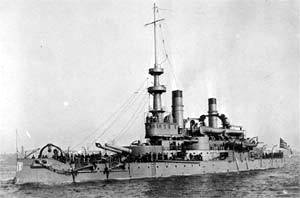
.jpg)
Majestic class
Charlemagne class
Fuji class
Emanuele Filiberto class
Kaiser Friedrich III class
Shikishima class
.jpg)
Canopus class
Kearsarge class
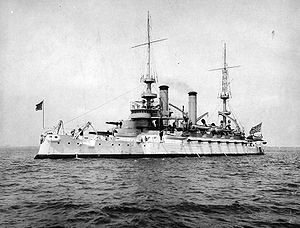
Illinois class
_1912.jpg)
Habsburg class
Borodino class
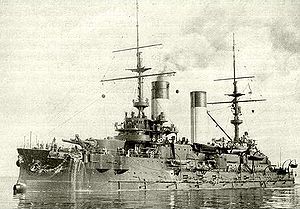
Regina Margherita class
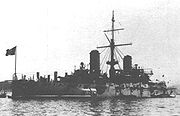
Virginia class
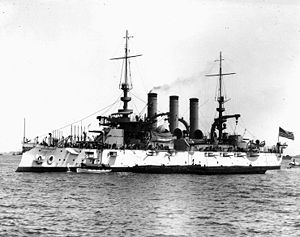
Formidable class

Maine class

Wittelsbach class
République class
King Edward VII class
.jpg)
Duncan class

Erzherzog Karl class
Liberté class battleship
Braunschweig class
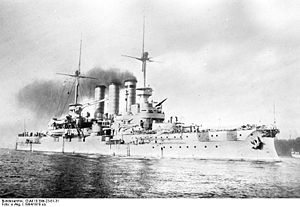
Regina Elena class
Katori class

Connecticut class
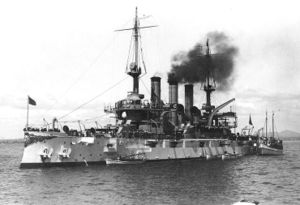
Deutschland class
Evstafi class
Andrei Pervozvanny class
Mississippi class
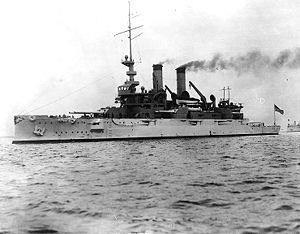
Invincible class
_british_battleship.jpg)
Nassau class
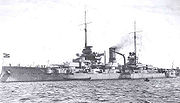
Lord Nelson class
Bellerophon class
Danton class

Radetzky class
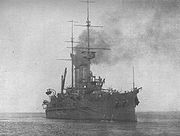
Kawachi class
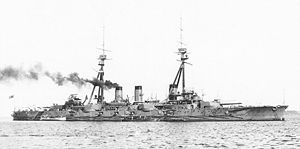
St. Vincent class
.png)
South Carolina class
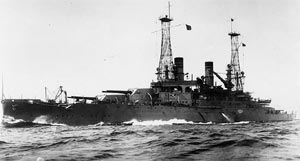
Minas Geraes class

Satsuma class

Delaware class

Indefatigable class
.jpg)
Colossus class
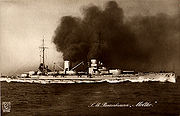
Florida class
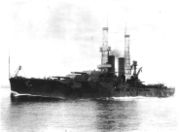
Courbet class
.jpg)
Helgoland class
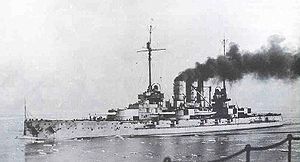
Gangut class
Imperatritsa Mariya class
Orion class
.jpg)
Lion class
Wyoming class
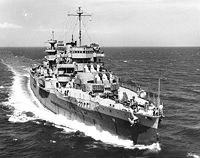
King George V class

Tegetthoff class
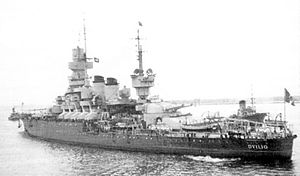
Andrea Doria class
Kongō class
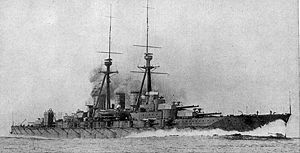
König class
Iron Duke class

New York class
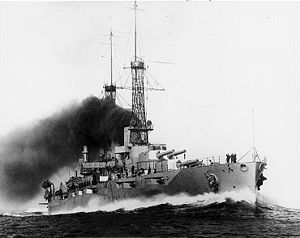
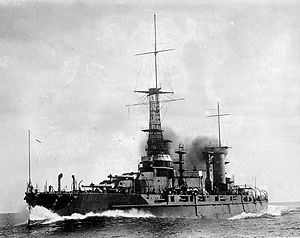
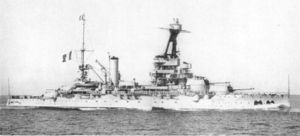
Bretagne class
Normandie class

Conte di Cavour class
Borodino class
Queen Elizabeth class
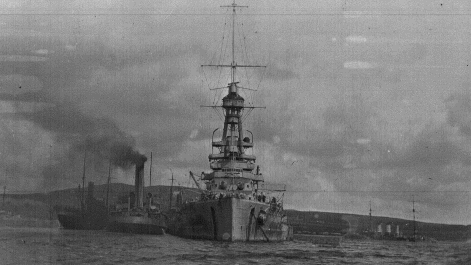
Bayern class
Revenge class
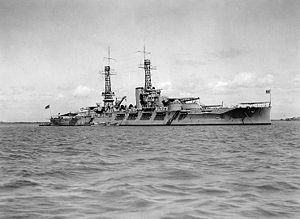
Nevada class
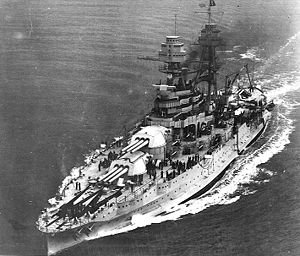
Pennsylvania class
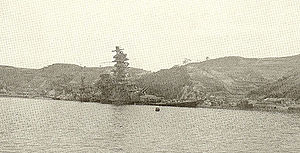
Ise class

New Mexico class
Admiral class

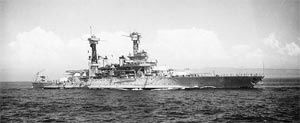
Tennessee class
Nagato class
Caracciolo class
Tosa class
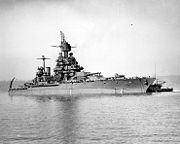
Colorado class
South Dakota class

Dunkerque class
Scharnhorst class
Littorio class
Richelieu class
Bismarck class
King George V class
Lion class
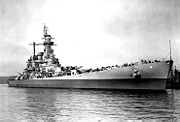
Yamato class
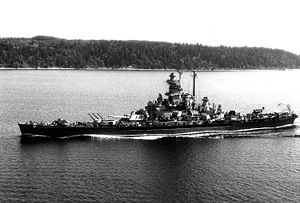
South Dakota class
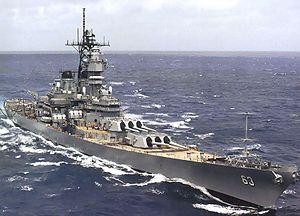
Iowa class
1939 H class

Montana class
1944 H class
Sovetsky Soyuz class
Vanguard class
Ship class
A ship class is a group of ships of a similar design. This is distinct from a ship-type, which might reflect a similarity of tonnage or intended use. For example, the is a nuclear aircraft carrier of the Nimitz class....
listed in chronological order by first commission. Classes which did not enter service are listed by the date of cancellation or last work on the project.
Unique battleships not part of a class (such as HMS Vanguard
HMS Vanguard (23)
HMS Vanguard was a British fast battleship built during World War II and commissioned after the end of the war. She was the only ship of her class and was the biggest, fastest and last of the Royal Navy's dreadnoughts, and the final battleship to be launched in the world...
) are found separately under List of battleships, which also includes individual battleships within the classes listed below.
See also:
- List of battleships for individual ships
- List of battleships by country
Gloire class
- Country:
- Displacement: 5,630 tons
- Armament: 36 x 163 mm guns
- Armor: 110 mm
- Speed: 13 knots (25 km/h)
- Ships in class: 3: La Gloire, Normandie, and Invincible
- Launched: 1859
Warrior class
- Country:
- Displacement: 9,140 tons
- Armament: after 1867- 4 × 8 in (203 mm), 28 × 7 in (178 mm) RBL, 4 x 20 pdr
- Armor: 4.5 in (114 mm) armor on 18 in (457 mm) wood.
- Speed: 14 knots (27 km/h) under steam
- Ships in class: 2: HMS WarriorHMS Warrior (1860)HMS Warrior was the first iron-hulled, armour-plated warship, built for the Royal Navy in response to the first ironclad warship, the French Gloire, launched a year earlier....
and HMS Black PrinceHMS Black Prince (1861)HMS Black Prince was the third ship of that name to serve with the Royal Navy. She was the world's second ocean-going, iron-hulled, armoured warship, following her sister ship, . For a brief period the two s were the most powerful warships in the world, being virtually impregnable to the naval guns... - Launched: 1860
Magenta class
- Country:
- Ships in class: 2: Magenta and Solferino
- Launched: 1861
- Fate: Magenta exploded 1875
Terribile class
- Country:
 Italy
Italy - Ships in class: 2: Terribile and Formidabile
- Launched: 1861
Provence class
- Country:
- Ships in class: 10: Provence, Héroine, Savoie, Flandre, Magnanime, Surveillante, Valeureuse, Gauloise, Guyenne, and Revanche
- Launched: 1863
Principe di Carignano class
- Country:
 Italy
Italy - Ships in class: 3: Principe di Carignano, Messina, and Conte Verde
- Launched: 1863
Re d'Italia class
- Country:
 Italy
Italy - Ships in class: 2: Re d'Italia and Re di Portogallo
- Launched: 1863
Regina Maria Pia class
- Country:
 Italy
Italy - Ships in class: 4: Regina Maria Pia, San Martino, Castelfidardo, and Ancona
- Launched: 1863
Pervenets class
- Country:
 Russian Empire
Russian Empire - Ships in class: 3: PervenetsRussian ironclad PervenetsThe Russian ironclad Pervenets was a broadside ironclad built for the Imperial Russian Navy in Britain during the 1860s. The ship had to be built abroad as no Russian shipyard had mastered the techniques required to build iron-hulled armored vessels. She was assigned to the Baltic Fleet upon...
, Ne Tron MeniaRussian ironclad Ne Tron MeniaThe Russian ironclad Ne Tron Menia was the second of the three broadside ironclads built for the Imperial Russian Navy during the mid-1860s. She joined the Baltic Fleet upon completion and never left Russian waters. Beginning in 1870 the ship was assigned to the Gunnery Training Detachment and...
, and KremlRussian ironclad KremlThe Russian ironclad Kreml was a broadside ironclad built for the Imperial Russian Navy during the mid-1860s.... - Launched: 1863
Numancia class
- Country:
 Spain
Spain - Ships in class: 1: NumanciaSpanish ironclad NumanciaThe Spanish ironclad Numancia was an armored frigate bought from France during the 1860s. She was the first ironclad to circumnavigate the Earth. She saw service in the Chincha Islands War.-External links:*...
- Launched: 1863
Vitoria class
- Country:
 Spain
Spain - Ships in class: 1: VitoriaSpanish ironclad VitoriaThe Spanish ironclad Vitoria was an iron-hulled armored frigate bought from England during the 1860s.-External links:*...
- Launched: 1865
Roma class
- Country:
 Italy
Italy - Ships in class: 2: Roma and Venezia
- Launched: 1865
Océan classOcéan class ironcladThe Océan class ironclads were a group of three wooden-hulled armored frigates built for the French Navy in the mid to late 1860s. attempted to blockade Prussian ports in the Baltic Sea in 1870 during the Franco-Prussian War. participated in the French occupation of Tunisia in 1881. was often...
- Country:
- Ships in class: 3: Océan, MarengoFrench ironclad MarengoMarengo was a wooden-hulled, armored frigate of the , built for the French Navy in the mid to late 1860s. The ship was running her sea trials in July 1870 when the Franco-Prussian War began and was immediately placed in reserve until after the war was over...
, and SuffrenFrench ironclad SuffrenSuffren was a wooden-hulled, armored frigate of the , built for the French Navy in the mid to late 1860s as an improvement over the . Although she was laid down in 1866, the ship was not launched until 1872 and commissioned in 1876... - Launched: 1868
Cerberus class
- Country:
- Ships in class: 2: HMVS CerberusHMVS CerberusHMVS Cerberus is a breastwork monitor that served in the Victoria Naval Forces, the Commonwealth Naval Forces , and the Royal Australian Navy between 1871 and 1924....
, HMS Magdala - Launched: 1868
Audacious class

- Country:
- Displacement: 6,034 tons
- Armament: 10 × 9 in (229 mm) guns, 4 × 6 in (152 mm) guns, 6 x 20 pounder guns, ram
- Armor: 200 mm belt, 150 mm battery
- Speed: 13 knots (25 km/h)
- Ships in class: 4: HMS AudaciousHMS Audacious (1869)HMS Audacious was the lead ship of the s built for the Royal Navy in the late 1860s. They were designed as second-class ironclads suitable for use on foreign stations and the ship spent the bulk of her career on the China Station. She was decommissioned in 1894 and hulked in 1902 for use as a...
, HMS InvincibleHMS Invincible (1869)HMS Invincible was an Audacious-class ironclad battleship of the Royal Navy. She was built at the Napier shipyard and completed in 1870. Completed just 10 years after , she still carried sails as well as a steam engine.-Armament:...
, HMS Iron DukeHMS Iron Duke (1870)The first HMS Iron Duke was an iron Audacious-class central battery ironclad.She was originally to have been called HMS Duke but she was nicknamed Iron Duke during construction as she was armoured unlike many other vessels under construction. The phrase was already in circulation as it was a...
, and HMS Vanguard - Launched: 1869
Swiftsure classSwiftsure class battleship (1870)The Swiftsure class battleships of the late Victorian era were broadside ironclads designed and built specifically for service as Flagships on the Pacific station....
- Country:
- Displacement: 6,910 tons
- Armament: 10 × 9 in (229 mm) guns, 4 × 6 in (152 mm) guns
- Ships in class: 2: HMS SwiftsureHMS Swiftsure (1870)HMS Swiftsure was the lead ship of the Swiftsure class battleships built in the late Victorian era. Her sister-ship was .-Service history:...
, HMS TriumphHMS Triumph (1870)HMS Triumph was a broadside ironclad battleship of the Victorian era, the sister-ship of . These two ships comprise the Swiftsure class of 1870.... - Launched: 1870
.jpg)
Devastation classDévastation class ironcladThe French Dévastation class battleships were laid down as part of the 1872 programme. They were a development of the Redoutable ....
- Country:
- Displacement: 9,188 tons
- Armament: 4 × 12 in (305 mm) guns
- Armor: 300 mm belt, 380 mm turret
- Performance: Speed 13 knots (25 km/h); Range 4700 nautical miles (8,704.4 km)
- Ships in class: 2: HMS DevastationHMS Devastation (1871)HMS Devastation was the first of two Devastation-class mastless turret ships built for the British Royal Navy. This was the first class of ocean-going capital ship that did not carry sails, and the first whose entire main armament was mounted on top of the hull rather than inside it...
, HMS ThundererHMS Thunderer (1872)HMS Thunderer was a British Royal Navy Devastation-class battleship.Thunder was an ironclad turret ship designed by Edward James Reed with revolving turrets, launched in 1872... - Launched: 1871
- Fate: Decommissioned by 1909 and scrapped
Principe Amedeo class
- Country:
 Italy
Italy - Ships in class: 2: Palestro and Principe Amedeo
- Launched: 1871
Superb class
- Country: (for )
- Ships in class: 2: HMS SuperbHMS Superb (1875)HMS Superb was an ironclad battleship designed by Sir Edward Reed for the Ottoman Navy, and was built in Britain by Thames Ironworks under the name of Hamidieh. She had both engines and sails....
(United Kingdom) and Messudieh (Turkey) - Launched: 1875
Colbert classColbert class ironcladThe Colbert class was a class of ironclad frigates of the French Navy...
- Country:
- Ships in class: 2: Colbert and TridentFrench ironclad TridentTrident was a wooden-hulled, armored frigate of the , built for the French Navy in the 1870s....
- Launched: 1875
Duilio class
- Country:
 Italy
Italy - Ships in class: 2: Caio DuilioItalian ironclad Caio DuilioCaio Duilio was the lead ship in a class of two ironclad battleships built in Italy for the Regia Marina in the 1870s. A revolutionary design fitted with the largest guns available, 100-ton 450 mm calibre muzzle-loading guns, she and her sister ship were regarded as the most powerful warships...
and Enrico DandoloItalian ironclad Enrico DandoloEnrico Dandolo was an ironclad battleship built in Italy for the Regia Marina in the 1870s. Designed by Benedetto Brin, together with her sister ship , and armed with 100-ton, 450 mm muzzle-loading Armstrong guns, she was considered the most powerful battleship of the time... - Launched: 1876
Belleisle class
- Country:
- Ships in class: 2: HMS BelleisleHMS Belleisle (1876)HMS Belleisle was one of the four ships currently under construction for foreign navies in British shipyards which were purchased by the British government for the Royal Navy in 1878, at the time of the Russian war scare....
and HMS OrionHMS Orion (1879)HMS Orion was a of the Victorian Royal Navy. Originally constructed for the Ottoman Empire, and called Bourdjou-Zaffer, she was purchased by the British Government before completion.... - Launched: 1876
Ajax classAjax class battleshipThe Ajax class of battleships consisted of two ships, and . They were ironclad ships serving in the Victorian Royal Navy, armed with turret-mounted main armament....
- Country:
- Ships in class: 2: HMS AjaxHMS Ajax (1880)HMS Ajax was the first of the two Royal Navy Ajax class ironclad battleships to be laid down, but was completed one day later than her sister,...
and HMS AgamemnonHMS Agamemnon (1879)HMS Agamemnon was a Victorian Royal Navy Ajax class ironclad turret battleship, the sister-ship of .Agamemnon and Ajax were built to the same design, and were smaller and less expensive versions of Inflexible... - Launched: 1879
Dévastation classDévastation class ironcladThe French Dévastation class battleships were laid down as part of the 1872 programme. They were a development of the Redoutable ....
- Country:
- Ships in class: 2: Courbet and Dévastation
- Launched: 1879
Italia classItalia class battleshipThe Italia-class battleships were a class of two Italian battleships which served in the Regia Marina during the late 19th and early 20th centuries...
- Country:
 Italy
Italy - Ships in class: 2: ItaliaItalian battleship Italia (1880)Italia was an Italian battleship launched in 1880, the lead ship of the Italia class. She served in the Regia Marina during the late 19th and early 20th centuries...
and LepantoItalian battleship LepantoLepanto was an Italian battleship launched in 1883, the second and last ship of the Italia class. She served in the Regia Marina during the late 19th and early 20th centuries... - Launched: 1880
Conqueror class
- Country:
- Ships in class: 2: HMS ConquerorHMS Conqueror (1881)HMS Conqueror was an ironclad battleship of the Victorian Royal Navy, whose main armament was an armoured ram.She was the first ship of the Conqueror class to be laid down, her only sister-ship being , which was completed some two years later...
and HMS HeroHMS Hero (1885)HMS Hero was the second and final Conqueror-class battleship. She was an ironclad who served in the Victorian Royal Navy.Hero was — like her sister-ship — designed to be an improved version of with a ram as her main armament... - Launched: 1881
Terrible class
- Country:
- Ships in class: 4: Terrible, Indomptable, Caïman, and Requin
- Launched: 1881
Dingyuan class
- Country:
 Imperial China
Imperial China - Displacement: 7,220 tons 7,670 tons full load
- Armament: 4 × 305 mm
- Armor: 355 mm belt
- Speed: 15.4 knots (30.2 km/h)
- Ships in class: 2: Dingyuan, Zhenyuan
- Launched: 1882
Admiral classAdmiral class battleshipThe British Royal Navy's pre-dreadnought Admiral class battleships of the 1880s followed the pattern of the Devastation class in having the main armament on centre-line mounts with the superstructure in between. This pattern was followed by most following British designs until in 1906...

- Country:
- Displacement: 10,600 tons
- Armament: 4 × 12 in (305 mm)es, or 4 x 13.5 inches (343 mm) guns or 2 x 16.25 inch guns, 4 × 6 in (152 mm) guns, 12 x 6 pounder guns, 10 x 3 pounder guns
- Armor: 18 inch belt
- Speed: 17 knots (33 km/h)
- Ships in class: 6: HMS CollingwoodHMS Collingwood (1882)HMS Collingwood was an ironclad battleship of the Royal Navy. She was the first example of the Admiral-class and was named after Admiral Cuthbert Collingwood, Horatio Nelson's second-in-command in the British victory at the Battle of Trafalgar....
, HMS RodneyHMS Rodney (1884)HMS Rodney was a battleship of the Victorian Royal Navy, a member of the Admiral class of warships designed by Nathaniel Barnaby.She was a development of the design of Collingwood, but carried 13.5 inch calibre main armament as against 12 inch in the earlier ship...
, HMS HoweHMS Howe (1885)HMS Howe was an Admiral-class battleship of the Royal Navy, the last of the Admiral-class to be completed.Along with her sisters, , and , she was a progressive development of the design of . She carried a main armament of four guns, compared to the guns carried in the earlier ship...
, HMS CamperdownHMS Camperdown (1885)HMS Camperdown was an Admiral-class battleship of the Royal Navy, named after Adam Duncan, 1st Viscount Duncan of Camperdown.She was a full sister to , and was an improved version of the earlier and . In comparison to these earlier ships, she had an increased thickness of barbette armour, and a...
, HMS AnsonHMS Anson (1886)HMS Anson was a pre-dreadnought battleship of the British Royal Navy, and was the last member of the Admiral-class to be laid down....
, and HMS BenbowHMS Benbow (1885)HMS Benbow was a Victorian era Admiral-class battleship of the British Royal Navy, named for Admiral John Benbow.With the exception of her armament she was a repeat of HMS Anson and HMS Camperdown. The contract for her construction was awarded to Thames Ironworks, and stipulated delivery within... - Launched: 1882 - 1886
Amiral Baudin class
- Country:
- Ships in class: 2: Amiral Baudin and Formidable
- Launched: 1883
Ruggiero di Lauria classRuggiero di Lauria class battleshipThe Ruggiero di Lauria class was a class of Italian battleships which served in the Regia Marina during the late 19th and early 20th centuries...
- Country:
 Italy
Italy - Ships in class: 3: Ruggiero di LauriaItalian battleship Ruggiero di LauriaRuggiero di Lauria was an Italian battleship launched in 1884. She was the lead ship of the Ruggiero di Lauria-class pre-dreadnoughts, and served in the Regia Marina during the late 19th and early 20th centuries.-Design:...
, Francesco MorosiniItalian battleship Francesco Morosini (1885)The first Francesco Morosini was an Italian battleship launched in 1885. She was the second ship of the Ruggiero di Lauria-class pre-dreadnoughts, and served in the Regia Marina during the late 19th and early 20th centuries....
, and Andrea DoriaItalian battleship Andrea Doria (1885)The Andrea Doria was an Italian battleship, the first named after Andrea Doria, launched in 1885. She was the third and final ship of the Ruggiero di Lauria-class pre-dreadnoughts, and served in the Regia Marina during the late 19th and early 20th centuries.-Design:The Ruggiero di Lauria class was... - Launched: 1884

Colossus classColossus class battleship (1882)The Colossus class battleships were ironclad warships, carrying their main armament in turrets, which served in the Victorian Royal Navy from 1882...
- Country:
- Displacement: 9,520 tons
- Armament: 4 x 12.5 inches (318 mm) guns, 5 × 6 in (152 mm) guns
- Speed: 15.5 knots (30.4 km/h)
- Ships in class: 2: HMS ColossusHMS Colossus (1882)The second HMS Colossus was a Colossus class second-class British battleship, launched in 1882 and commissioned in 1886. She had a displacement of 9,520 tons, and an armament of 4 × 12-inch breechloaders, 5 × 6-inch guns and had a respectable speed of 15.5 knots. She served in the Mediterranean...
and HMS EdinburghHMS Edinburgh (1882)HMS Edinburgh was an ironclad battleship of the Colossus class which served in the Royal Navy of the Victorian era. She was the sister ship of HMS Colossus, being started before her but being completed after.... - Launched: 1882
- Fate: Both scrapped by 1910
Ekaterina II class
- Country:
- Ships in class: 4: Ekaterina IIRussian battleship Ekaterina II- External links :* *...
, ChesmaRussian battleship Chesma (1886)The Chesma was the second ship of the pre-dreadnought battleships built for the Imperial Russian Navy in the 1880s. When the ship was completed she proved to be very overweight which meant that much of her waterline armor belt was submerged...
, SinopRussian battleship SinopThe Russian battleship Sinop was a pre-dreadnought battleship built for the Imperial Russian Navy, being the third ship of the . She was named after the Russian victory at the Battle of Sinop in 1853...
, and Georgii PobedonosetsRussian battleship Georgii PobedonosetsThe Georgii Pobedonosets was a pre-dreadnought battleship built for the Imperial Russian Navy, the fourth and final ship of the . She was, however, only a half-sister to the others as her armor scheme was different and she was built much later than the earlier ships... - Launched: 1886
Pelayo class
- Country:
- Displacement: 9,745 tons
- Armament: 2 × 12.6 in (320 mm) Hontoria guns, 2 × 11 in (280 mm) Hontoria guns, 1 × 6.3 in (160 mm) gun, 3 × 2.24 in (57 mm) Hotchkiss guns, 13 × 1.45 in (37 mm) guns, 4 machine guns, 7 bow torpedo tubes.
- Speed: 16.7 knots (32.7 km/h)
- Ships in class: 1: PelayoSpanish battleship PelayoPelayo was a battleship of the Spanish Navy which served in the Spanish fleet from 1888 to 1925. For many years, she was the most powerful unit of the Spanish Navy.-Technical Characteristics:...
- Launched: June 3, 1888
- Fate: Scrapped by 1925
Victoria classVictoria class battleshipThe Royal Navy's Victoria class battleships of the 1880s was the first class which used triple expansion steam engines, previous battleships having used compound engines.There were only two ships in this class...
- Country:
- Displacement: 11,020 tons
- Armament: 2 x 16.25 inch guns, 1 × 10 in (254 mm) gun, 12 × 6 in (152 mm) guns, 6 × 14 in (356 mm) torpedo tubes
- Armor: 18 inch belt
- Speed: 17 knots (33 km/h)
- Ships in class: 2: HMS VictoriaHMS Victoria (1887)HMS Victoria was the lead ship in her class of two battleships of the Royal Navy. On 22 June 1893, she collided with near Tripoli, Lebanon during manoeuvres and quickly sank, taking 358 crew with her, including the commander of the British Mediterranean Fleet, Vice-Admiral Sir George Tryon...
and HMS Sans PareilHMS Sans Pareil (1887)HMS Sans Pareil was a Victoria Class battleship of the British Royal Navy of the Victorian era, her only sister-ship being .In deciding upon her design configuration the Board of Admiralty took what history shows was a retrograde step by requesting the reversion from barbettes to turrets for her... - Launched: 9 June 1887
- Fate: Victoria sunk in collision in 1893
Marceau class
- Country:
- Ships in class: 3: MarceauFrench battleship Marceau (1887)The Marceau was an ironclad battleship of the French Navy, lead ship of her class.She served in the Mediterranean Squadron until 1900, when she was rebuilt. She returned to service in 1906 as a school ship for torpedo warfare....
, Neptune, and MagentaFrench battleship Magenta (1890)The Magenta was an ironclad battleship of the French Navy. The ship underwent significant changes during her construction phase including three different sets of main guns and increases in length and width. Like her sister ships she suffered from an over-large unarmoured superstructure that in... - Launched: 1887
Imperator Aleksandr II class
- Country:
- Ships in class: 2: Imperator Aleksandr IIRussian battleship Imperator Aleksandr IIImperator Aleksandr II was a pre-dreadnought battleship built for the Imperial Russian Navy in the 1880s. She was an artillery training ship assigned to the Baltic Fleet by the time of the Russo-Japanese War of 1905 and was not sent to the Pacific as was most of the rest of the Baltic Fleet...
and Imperator Nikolai IRussian battleship Imperator Nikolai IImperator Nikolai I was a Russian pre-dreadnought battleship built for the Baltic Fleet in the late 1880s. She participated in the celebration of the 400th anniversary of the discovery of America in New York City in 1892. She assigned to the Mediterranean Squadron and visited Toulon in October 1893... - Launched: 1887
Re Umberto classRe Umberto class battleshipThe Umberto Re class were a group of pre-dreadnought battleships built for the Italian Navy in the 1880s. All three ships of the class saw service during World War I in secondary roles.-Description:...
- Country:
 Italy
Italy - Ships in class: 3: Re UmbertoItalian battleship Re UmbertoRe Umberto was a pre-dreadnought battleship built for the Italian Navy in the 1880s. She was the lead ship of her class. She was laid down in 1884; work proceeded so slowly that she was not finished until 1893....
, SardegnaItalian battleship SardegnaSardegna was a pre-dreadnought battleship built for the Italian Navy in the 1880s. She was the third ship of her class laid down, but the second finished.-General characteristics:...
, and SiciliaItalian battleship SiciliaSicilia was a pre-dreadnought battleship built for the Italian Navy in the 1880s. She was the second ship of her class to be laid down, but was the last to be completed. Decommissioned before World War I she was used during the war as a depot ship at Taranto and then became a repair ship... - Launched: 1888
Trafalgar classTrafalgar class battleshipThe two Trafalgar-class battleships of the British Royal Navy were late nineteenth century ironclad warships. Both were named after naval battles won by the British during the Napoleonic wars under the command of Admiral Nelson.-Design:...
- Country:
- Displacement: 11,940 tons
- Armament: 4 x 13.5 inches (343 mm) guns, 6 x 4.7 inch QF guns
- Armor: 20 inch belt
- Speed: 17 knots (33 km/h)
- Ships in class: 2: HMS TrafalgarHMS Trafalgar (1887)HMS Trafalgar was one of two Trafalgar class battleships commissioned in 1890 and 1891, the other being HMS Nile.-Design:They were designed to be improved versions of the Admiral and Victoria classes, having a greater displacement to allow for improved protection...
and HMS NileHMS Nile (1888)HMS Nile was a battleship of the Royal Navy of the Victorian era, a ship of the Trafalgar class, and the only sister-ship of HMS Trafalgar.... - Commissioned: 2 April 1891
- Fate: Scrapped
.jpg)
Royal Sovereign classRoyal Sovereign class battleshipThe Royal Sovereign class was a class of pre-dreadnought battleships of the British Royal Navy. The class comprised seven ships built to the same design: HMS Royal Sovereign, , HMS Ramilles, HMS Repulse, HMS Resolution, HMS Revenge, and HMS Royal Oak, and a half-sister built to a modified design: ....
- Country:
- Displacement: 14,150 tons
- Armament: 4 x 13.5 inches (343 mm) guns, 10 × 6 in (152 mm) guns, 16 x 6 pounder guns, 12 x 3 pounder guns, 7 × 18 in (457 mm) torpedo tubes
- Armor: 18 inch belt
- Speed: 17 knots (33 km/h)
- Ships in class: 8: HMS Royal SovereignHMS Royal Sovereign (1891)HMS Royal Sovereign was a Royal Sovereign class battleship of the Royal Navy, the lead ship of the class, and the largest warship in the world at the time of her construction. The ships were designed by Sir William White and were the most potent battleships in the world until HMS Dreadnought...
, HMS HoodHMS Hood (1891)The second warship to be named HMS Hood was a modified Royal Sovereign-class battleship of the Royal Navy, and the last of the eight built. She differed from the Royal Sovereign class in that she had cylindrical gun turrets instead of barbettes, a lower freeboard and a higher metacentric height...
, HMS Empress of IndiaHMS Empress of India (1891)HMS Empress of India was a pre-dreadnought battleship of the Royal Navy and part of the eight-ship Royal Sovereign class. She was laid down at Pembroke Dockyard on 9 July 1889 and launched by the Duchess of Connaught on 7 May 1891. Initially known as HMS Renown, her name was changed before...
, HMS RamilliesHMS Ramillies (1892)HMS Ramillies was a pre-dreadnought battleship of Royal Navy and part of the seven ship Royal Sovereign' class.-Technical Characteristics:...
, HMS RepulseHMS Repulse (1892)HMS Repulse was a Royal Sovereign-class predreadnought battleship of the Royal Navy. She was the tenth ship to bear the name HMS Repulse.-Technical Characteristics:HMS Repulse was ordered under the Naval Defence Act Program of 1889...
, HMS ResolutionHMS Resolution (1892)HMS Resolution was a Royal Sovereign-class predreadnought battleship of the Royal Navy.-Technical characteristics:Resolution was laid down by Palmers on 14 June 1890, launched on 28 May 1892, and completed in November 1893.. She was long and had a maximum cruising speed of...
, HMS RevengeHMS Revenge (1892)HMS Revenge was a pre-dreadnought battleship of the Royal Sovereign class of the British Royal Navy. She was renamed HMS Redoubtable in 1915. HMS Revenge notably served as the flagship of the Flying Squadron and bombarding the coast of Flanders during World War I before being refitted as an...
, and HMS Royal OakHMS Royal Oak (1892)HMS Royal Oak was a pre-dreadnought Royal Navy battleship of the seven-ship Royal Sovereign class.-Technical Characteristics:Royal Oak was ordered under the Naval Defence Act Programme of 7 March 1889 and built by Cammell Laird at Birkenhead at a cost of £977,996. She was launched on 5 November 1892... - Commissioned: 1891
Centurion classCenturion class battleshipThe Centurion class battleships were second-class pre-dreadnought battleships of the Royal Navy designed for service on distant stations.-Description:...
- Country:
- Ships in class: 3: HMS CenturionHMS Centurion (1892)HMS Centurion was a predreadnought second-class battleship of the Royal Navy. She was part of the three-ship Centurion class, designed for long-range patrolling of the United Kingdom's far-flung empire.-Technical characteristics:...
, HMS BarfleurHMS Barfleur (1892)HMS Barfleur was a predreadnought second-class battleship of the Royal Navy. She was part of the three-ship Centurion class, designed for long-range patrolling of the United Kingdom's far-flung empire. She mainly saw service in the Mediterranean and Home Fleet, along with Service at China Station,...
and HMS RenownHMS Renown (1895)HMS Renown was a predreadnought battleship of the Royal Navy. Third and last of the lightly armed, long-range Centurion class, she had an upgraded design compared to her two sister ships HMS Centurion and HMS Barfleur.... - Launched: 1891
Brandenburg classBrandenburg class battleshipThe four Brandenburg-class pre-dreadnought battleships were Germany's first ocean-going battleships. They were also the first German warship, of any type, to be fitted with wireless communications. The class comprised , , , and . All were laid down in 1890 and completed by 1893, except for...
- Country:
 Germany
Germany - Displacement: 10,670 tonnes max
- Armament: 6 x 28 cm (11") guns (4 x 40cal, in dual turrets fore & aft; 2 x 35cal., in sgl turret amidships); 6 x 10.5 cm 35 cal QF guns (later increased to 8); 8 x 8.8 cm 30 cal QF guns; 12 x machineguns; 6 x 45 cm torpedo tubes
- Armor: 300–400 mm belt; 300 mm barbette; 60 mm deck
- Performance: Speed 16.5 knots (32 km/h); Range 4300 nautical miles (7,963.6 km) at 10 knots (20 km/h)
- Ships in class: 4: SMS Kurfürst Friedrich WilhelmSMS Kurfürst Friedrich WilhelmSMS Kurfürst Friedrich Wilhelm"SMS" stands for "Seiner Majestät Schiff", or "His Majesty's Ship" in German. was one of the first ocean-going battleshipsAt the time she was laid down, the German navy referred to the ship as an "armored ship" , instead of "battleship" , see Gröner, p13. of the German...
, SMS BrandenburgSMS BrandenburgSMS Brandenburg was the lead ship of the Brandenburg-class pre-dreadnought battleships, which included , , and built for the German Kaiserliche Marine in the early 1890s. She was the first pre-dreadnought built for the German Navy; earlier, the Navy had only built coastal defense ships and...
, SMS Weißenburg, and SMS WörthSMS WörthSMS Wörth was one of four German pre-dreadnought battleships of the Brandenburg class, built in the early 1890s. The ships were the first ocean-going battleships built by the Kaiserliche Marine . Wörth was laid down at the Germaniawerft dockyard in Kiel in May 1890. The ship was launched on 6... - Service: Commissioned 1893-4
Evertsen class
- Country:
- Ships in class: 3: HNLMS Evertsen, HNLMS Piet Hein, and HNLMS Kortenaer
- Launched: 1894
Petropavlovsk class
- Country:
- Ships in class: 3: PetropavlovskRussian battleship Petropavlovsk (1897)The Petropavlovsk was the lead ship of the Petropavlovsk class of battleships built for the Imperial Russian Navy. During the Russo-Japanese War, Petropavlovsk was a flagship of the First Pacific Squadron, taking part in battles against the Imperial Japanese Navy. On March 31, 1904, the battleship...
, Poltava, and SevastopolRussian battleship Sevastopol (1895)Sevastopol was the last of three ships in the Petropavlovsk class of pre-dreadnought battleships built for the Imperial Russian Navy in the 1890s... - Launched: 1894
Monarch classMonarch class battleshipThe Monarch class was a class of battleships, although resembling coastal defence ships, built by Austria-Hungary at the end of the 19th century. The Monarchs were the first ships of their type to utilize turrets. The class comprised three ships: , , and , each armed with two L/40 guns in two...
- Country:
- Ships in class: 3: SMS Monarch, SMS WienSMS WienSMS Wien was a pre-dreadnought battleship and coastal defense ship of the Monarch class that was constructed by the Austro-Hungarian Navy at the end of the 19th century. The Wien was laid down in the Stabilimento Tecnico Triestino shipyards in Trieste on the same day as her sister ship Budapest,...
, SMS BudapestSMS BudapestSMS Budapest was a pre-dreadnought battleship and coastal defense ship of the Monarch class that was constructed by the Austro-Hungarian Navy at the end of the 19th century. The Budapest was laid down in the Stabilimento Tecnico Triestino shipyards in Trieste on the same day as her sister ship... - Commissioned: 1895
- Fate: Wien torpedoed in 1917, others scrapped
Indiana classIndiana class battleshipThe three Indiana-class battleships were the first battleships to be built by the United States Navy comparable to contemporary European ships, such as the British . Authorized in 1890 and commissioned between November 1895 and April 1896, they were relatively small battleships with heavy armor and...

- Country:
- Displacement: 10,288 tons
- Armament: 4 × 13 in (330 mm) guns, 8 × 8 in (203 mm) guns, 4 × 6 in (152 mm) guns, 20 x 6-pounders, 6 x 1-pounders, 6 × 18 in (457 mm) surface torpedo tubes
- Speed: 15 knots (29 km/h)
- Ships in class: 3: USS IndianaUSS Indiana (BB-1)USS Indiana was the lead ship of her class and the first battleship in the United States Navy comparable to foreign battleships of the time. Authorized in 1890 and commissioned five years later, she was a small battleship, though with heavy armor and ordnance. The ship also pioneered the use of an...
, USS MassachusettsUSS Massachusetts (BB-2)USS Massachusetts was an and the second United States Navy ship comparable to foreign battleships of the time. Authorized in 1890 and commissioned six years later, she was a small battleship, though with heavy armor and ordnance. The ship class also pioneered the use of an intermediate battery...
, and USS OregonUSS Oregon (BB-3)USS Oregon was a pre-Dreadnought of the United States Navy. Her construction was authorized on 30 June 1890, and the contract to build her was awarded to Union Iron Works of San Francisco, California on 19 November 1890. Her keel was laid exactly one year later... - Commissioned: 20 November 1895
- Fate: Decommissioned 17 July 1920
.jpg)
Majestic classMajestic class battleshipThe Majestic class was a class of pre-dreadnought battleships, built under the Spencer Programme of 8 December 1893, that sought to counter the growing naval strength of France and the Russian Empire...
- Country:
- Displacement: 14,900 tons
- Armament: 4 × 12 in (305 mm) guns, 12 × 6 in (152 mm) guns, 16 x 12 pounder guns, 12 x 3 pounder guns, 5 × 18 in (457 mm) torpedo tubes
- Armor: 9 inch belt, 3 inch deck, 10 inch turret
- Speed: 19 knots (37 km/h)
- Ships in class: 9: HMS MajesticHMS Majestic (1895)HMS Majestic was a Majestic-class predreadnought battleship of the Royal Navy.-Technical characteristics:HMS Majestic was laid down at Portsmouth Dockyard on 5 February 1894 and launched on 31 January 1895...
, HMS MagnificentHMS Magnificent (1894)HMS Magnificent was one of the nine Majestic-class battleships of the Royal Navy .-Technical characteristics:HMS Magnificent was laid down on 18 December 1893 at Chatham Dockyard...
, HMS Prince GeorgeHMS Prince George (1895)HMS Prince George was a Majestic-class predreadnought battleship launched in 1895. She was named after the future George V of the United Kingdom and was the fourth and final ship to bear that name.-Technical description:...
, HMS VictoriousHMS Victorious (1895)HMS Victorious was one of nine Majestic-class predreadnought battleships of the British Royal Navy.-Technical characteristics:HMS Victorious was laid down at Chatham Dockyard on 28 May 1894 and launched on 19 October 1895...
, HMS JupiterHMS Jupiter (1895)HMS Jupiter was a Majestic-class pre-dreadnought battleship of the Royal Navy.-Technical characteristics:HMS Jupiter was laid down by J & G Thomson, Clydebank at Clydebank on 26 April 1894 and launched on 18 November 1895...
, HMS MarsHMS Mars (1896)HMS Mars was a Royal Navy predreadnought battleship of the Majestic class.-Technical characteristics:HMS Mars was laid down by Cammell Laird at Birkenhead on 2 June 1894 and launched on 3 March 1896...
, HMS HannibalHMS Hannibal (1896)HMS Hannibal was a Majestic class pre-dreadnought battleship and the sixth ship to bear the name HMS Hannibal.-Technical characteristics:...
, HMS CaesarHMS Caesar (1896)HMS Caesar was a Majestic-class pre-dreadnought battleship of the Royal Navy, named after the Roman military and political leader Julius Caesar.-Technical description:...
, and HMS IllustriousHMS Illustrious (1896)The third HMS Illustrious of the British Royal Navy was a Majestic-class pre-dreadnought battleship launched in 1896. She was in front-line service during the final years of the 19th century and early 20th century... - Launched: 1895
Charlemagne classCharlemagne class battleshipThe Charlemagne class was a class of pre-dreadnought battleships of the French Navy. It consisted of three ships, the Charlemagne, the St Louis and the Gaulois. Several other single ship classes were based on the Charlemagne class...
- Country:
- Ships in class: 3: CharlemagneFrench battleship Charlemagne (1895)The Charlemagne was a pre-dreadnought battleship of the French Navy. In 1915, along with her sister-ship Gaulois, she took part in the Naval operations in the Dardanelles Campaign, under admiral Émile Paul Amable Guépratte. She was named after Charlemagne, a famous Frankish king.-Design:The...
, GauloisFrench battleship Gaulois (1896)The Gaulois was a pre-dreadnought battleship of the French Navy.In 1915, along with her sister-ship Charlemagne, she took part in the Naval operations in the Dardanelles Campaign, under admiral Guépratte. The French squadron was leading the assault, and the Gaulois suffered hits from the Turkish...
, and St LouisFrench battleship St Louis (1896)The Saint Louis was a pre-dreadnought capital battleship of the French Navy. She was laid down in 1893, launched in 1896, and completed in 1900 as the third battleship of her class, the Charlemagne class. The ship saw service in the First World War, and was scrapped in 1933.-Design:The St Louis... - Launched: 1895
Fuji classFuji class battleship-External links:**...
- Country:
- Ships in class: 2: FujiJapanese battleship Fuji-External links:*...
and YashimaJapanese battleship Yashima|-External links:** The New York Times, June 2, 1905.... - Launched: 1896
Emanuele Filiberto classAmmiraglio di Saint Bon class battleshipThe Ammiraglio di Saint Bon-class were a pair of pre-dreadnought battleships built for the Italian Navy during the 1890s.-Service:Ammiraglio di Saint Bon was built by the Venice Naval Shipyard. She was laid down on 18 July 1893, launched on 29 April 1897, and completed on 24 May 1901, although she...
- Country:
 Italy
Italy - Ships in class: 2: Emanuele FilibertoItalian battleship Emanuele FilibertoThe Emanuele Filiberto was a pre-dreadnought battleship built for the Italian Navy during the 1890s.-Service:Emanuele Filiberto was named after Prince Emanuele Filiberto, Duke of Aosta. She was built by the Castellammare Naval Shipyard in Castellammare di Stabia, Naples...
and Ammiraglio di Saint Bon - Launched: 1897
Kaiser Friedrich III classKaiser Friedrich III class battleshipKaiser Friedrich III class battleships were a class of pre–World War I, pre-dreadnought battleships of the German Kaiserliche Marine. The class was made up of five ships, all of which were named for German emperors...
- Country:
 Germany
Germany - Displacement: 11,785 tons
- Armament: 4 x 24 cm (9.4") guns; 18 x 15 cm guns; 12 x 8.8 cm guns; 12 x machineguns; 6 x 45 cm torpedo tubes
- Armor: 225 mm belt; 250 mm turret; 50 mm deck
- Performance: Speed 17 knots (33 km/h); Range 3420 nautical miles (6,333.8 km) at 10 knots (20 km/h)
- Ships in class: 5: SMS Kaiser Friedrich IIISMS Kaiser Friedrich IIISMS Kaiser Friedrich III was the lead ship of the Kaiser Friedrich III class of pre-dreadnought battleships. She was laid down at the Kaiserliche Werft in Wilhelmshaven in 1895, and finished in October 1898...
, SMS Kaiser Wilhelm IISMS Kaiser Wilhelm IISMS Kaiser Wilhelm II was the second ship of the of pre-dreadnought battleships. She was built at the Imperial Dockyard in Wilhelmshaven and launched 14 September 1897. The ship was completed 7 October 1898 and commissioned into the fleet as flagship on 4 February 1902...
, SMS Kaiser Wilhelm der Grosse, SMS Kaiser Karl der Grosse, and SMS Kaiser BarbarossaSMS Kaiser BarbarossaSMS Kaiser Barbarossa was a German pre-dreadnought battleship of the . The ship was built for the Imperial Navy, which had begun a program of expansion at the direction of Kaiser Wilhelm II. She was constructed at Schichau, in Danzig... - Commissioned: 1898
Shikishima classShikishima class battleship-External links:**...
- Country:
- Ships in class: 2: ShikishimaJapanese battleship Shikishima|-External links:**...
and HatsuseJapanese battleship Hatsuse|-External links:**... - Launched: 1898
Peresvet class
- Country:
- Displacement: 12,683 tons
- Armament: 4 × 10 inchguns; 11 x 6 ich guns; 20 x 75 mm guns ; 5 × 15 inchtorpedo tubes
- Armor: 9 inch belt; 10 inch turret; 2.5 inch deck
- Performance: Speed 18 knots (35 km/h); Range 3500 nautical miles (6,482 km)
- Ships in class: 3: Peresvet, OslyabyaRussian battleship OslyabyaThe Oslyabya was a battleship of the Russian Imperial Navy, belonging to the . She was named for Rodion Oslyabya, a 14th century monk of the Troitse-Sergiyeva Lavra and a hero of the Battle of Kulikovo....
, and Pobeda - Launched: 1898
.jpg)
Canopus classCanopus class battleshipThe Canopus class was a group of six pre-dreadnought battleships of the Royal Navy which were designed by Sir William White for use in the Far East and entered service between 1899 and 1902. The lead ship was which was followed by , , , and...
- Country:
- Displacement: 12,950 tons
- Armament: 4 × 12 in (305 mm) guns, 12 × 6 in (152 mm) guns, 10 × 3 in (76 mm) guns, 4 × 18 in (457 mm) torpedo tubes
- Speed: 18 knots (35 km/h)
- Ships in class: 6: HMS Canopus, HMS GoliathHMS Goliath (1898)HMS Goliath was one of the six Canopus-class pre-dreadnought battleships built by the Royal Navy in the late 19th century. In the First World War Goliath took part in the blockade of the German light cruiser in the Rufiji River but unsuccessful to bombard the cruiser in the delta.On 13 May 1915...
, HMS AlbionHMS Albion (1898)HMS Albion was a British Canopus-class predreadnought battleship.-Technical Description:HMS Albion was laid down by Thames Iron Works at Leamouth, London on 3 December 1896...
, HMS OceanHMS Ocean (1898)The fourth HMS Ocean was a Canopus-class battleship of the British Royal Navy.-Technical Description:HMS Ocean was laid down at Devonport Dockyard on 15 December 1897, launched on 5 July 1898, and completed in February 1900...
, HMS GloryHMS Glory (1899)HMS Glory was a Royal Navy battleship of the Canopus class.-Technical Characteristics:HMS Glory and her five sister ships were designed for service in the Far East, where the new rising power Japan was beginning to build a powerful and dangerous navy, and to able to transit the Suez Canal...
, and HMS VengeanceHMS Vengeance (1899)HMS Vengeance was a Royal Navy predreadnought battleship of the Canopus class.-Technical Characteristics:HMS Vengeance was laid down by Vickers at Barrow-in-Furness on 23 August 1898 and launched on 25 July 1899. Her completion was delayed by damage to the fitting-out dock, and she was not... - Commissioned: December 1899
Herluf Trolle class
- Country:
- Ships in class: 2: KDM Herluf Trolle and KDM Olfert Fischer
- Launched: 1899
Kearsarge classKearsarge class battleshipThe Kearsarge class was a two-ship class of battleships built for the United States Navy at the beginning of the 20th century. Its first ship, the , was commissioned in 1900. The lead ship of this class, USS Kearsarge, was the only United States battleship not named for a state.- Ship history :This...

- Country:
- Displacement: 11,540 tons
- Armament: 4 × 13 in (330 mm) guns, 4 × 8 in (203 mm) guns, 14 × 6 in (152 mm) guns, 20 x 6-pounders, 8 x 1-pounders, 4 x 30-caliber machineguns
- Speed: 15 knots (29 km/h)
- Ships in class: 2: USS KearsargeUSS Kearsarge (BB-5)USS Kearsarge , the lead ship of her class of battleships, was the first ship of the United States Navy to be named, by act of Congress, in honor of the famous American Civil War sloop-of-war . Her keel was laid down by the Newport News Shipbuilding Company of Newport News, Virginia on 30 June...
and USS KentuckyUSS Kentucky (BB-6)USS Kentucky , a Kearsarge-class battleship, was launched on 24 March 1898 by Newport News Shipbuilding & Dry Dock Company of Newport News, Virginia, sponsored by Miss Christine Bradley, daughter of Governor William O'Connell Bradley of Kentucky, and commissioned on 15 May 1900, Captain Colby M... - Commissioned: 20 February 1900
- Fate: Decommissioned 29 May 1920
Illinois classIllinois class battleshipThe Illinois-class battleships were pre-dreadnought battleships of the United States Navy commissioned at the beginning of the 20th century. The first ship of its class, the , was commissioned in 1901...
_1912.jpg)
- Country:
- Displacement: 11,565 tons
- Armament: 4 × 13 in (330 mm) guns, 14 × 6 in (152 mm) guns, 16 x 6 pounders (2.7 kg), 6 x 1 pounders (454 g), 4 torpedo tubes
- Speed: 17 knots (33 km/h)
- Ships in class: 3: USS IllinoisUSS Illinois (BB-7)USS Illinois , the second ship of the United States Navy to be named for the 21st state, was a battleship, the lead ship of her class....
, USS AlabamaUSS Alabama (BB-8)USS Alabama was an pre-dreadnought style battleship in the United States Navy. She was the second ship to carry her name.Alabama was laid down on 1 December 1896 at Philadelphia, Pennsylvania, by the William Cramp and Sons Ship and Engine Building Company. She was launched on 18 May 1898...
, and USS WisconsinUSS Wisconsin (BB-9)USS Wisconsin , an Illinois-class battleship, was the first ship of the United States Navy to be named for the 30th state.The keel of Battleship No. 9 was laid down on 9 February 1897 at San Francisco, California, by the Union Iron Works... - Commissioned: 16 October 1900
- Fate: Decommissioned 17 July 1920
Habsburg classHabsburg class battleshipThe Habsburg class was a group of pre-dreadnought battleships built by Austria-Hungary at the turn of the 20th century. They were the first sea-going battleship built by Austria-Hungary since the center-battery ship Tegetthoff in 1876. The class was composed of three ships: , , and...
- Country:
- Ships in class: 3: SMS HabsburgSMS HabsburgSMS Habsburg was a pre-dreadnought battleship built by the Austro-Hungarian navy in 1899. The lead ship of the , she was launched on 9 September 1900. In 1903 and 1904, Habsburg and her sister ship Árpád conducted training exercises in the Mediterranean Sea. In 1906 and 1907, Habsburg was...
, SMS ÁrpádSMS ÁrpádSMS Árpád was a pre-dreadnought battleship built by the Austro-Hungarian Navy in the early 20th century. She was launched on 11 September 1901 as the second of three battleships. Along with her sisterships, she participated at the bombardment of Ancona during World War I...
, SMS BabenburgSMS BabenburgSMS Babenburg was a pre-dreadnought battleship built by the Austro-Hungarian Navy in 1899. She was launched on 4 October 1902 as the last of three battleships. Along with her sisterships, she participated at the bombardment of Ancona during World War I. At the end of the war, she was ceded to... - Commissioned: 1900
- Fate: Scrapped 1921
Koningin Regentes class
- Country:
- Ships in class: 3: HNLMS Koningin Regentes, HNLMS De Ruyter, and HNLMS Hertog Hendrik
- Launched: 1900
Borodino classBorodino class battleshipThe five Borodino-class battleships were pre-dreadnoughts built between 1899 and 1905 for the Imperial Russian Navy...

- Country:
- Displacement: 14,000 tons
- Armament: 4 x 305 mm guns, 12 x 152 mm guns, 20 x 75 mm guns, 20 x 47 mm guns, 4 × 15 in (381 mm) torpedo tubes
- Armor: 190 mm belt, 50 mm deck, 250 mm turret
- Speed: 18 knots (35 km/h)
- Range: 2590 nautical miles (4,796.7 km)
- Ships in class: 5: BorodinoRussian battleship BorodinoThe Borodino was the class leader of the , and the second ship of her class to be completed. The ship was named after the 1812 Battle of Borodino. Borodino was lost at the Battle of Tsushima on 27 May 1905 due to explosions set off by a Japanese shell hitting a 6-inch magazine...
, Imperator Aleksandr III, Oryol, Knyaz SuvorovRussian battleship Knyaz SuvorovThe Knyaz Suvorov was a pre-dreadnought battleship of the Russian Imperial Navy, built by Baltic Works, St Petersburg. Laid down in July 1901, she was launched in September 1902 and completed in September 1904. This ship was named after the 18th-century Russian general Alexander Suvorov. Her...
, and SlavaRussian battleship SlavaSlava was a pre-dreadnought battleship of the Imperial Russian Navy, the last of the five s. Commissioned too late to participate in the Battle of Tsushima during the Russo-Japanese War, she survived while all of her sister ships were either sunk during the battle or surrendered to the Imperial... - Launched: September 1901
- Fate: All but Slava lost at the battle of TsushimaBattle of TsushimaThe Battle of Tsushima , commonly known as the “Sea of Japan Naval Battle” in Japan and the “Battle of Tsushima Strait”, was the major naval battle fought between Russia and Japan during the Russo-Japanese War...
in 1905, Slava scuttled 1917
Regina Margherita classRegina Margherita class battleshipThe Regina Margherita was a class of battleships built for the Italian Regia Marina between 1898 and 1905. The class comprised two ships: Regina Margherita and Benedetto Brin....

- Country:
 Italy
Italy - Displacement: 14,574 tons
- Armament: 4 x 305 mm guns; 4 x 203 mm guns; 12 x 152 mm guns; 20 x 76 mm guns; 4 x 450 mm torpedo tubes
- Armor:
- Performance: Speed 20 knots (39 km/h); Range 10000 nautical miles (18,520 km) at 10 knots (20 km/h)
- Ships in class: 2: Regina MargheritaItalian battleship Regina MargheritaRegina Margherita was a pre-dreadnought battleship built for the Italian Regia Marina between 1898 and 1904.-Service:Regina Margherita was launched at La Spezia in 1901, and completed three years later. She was the flagship of the Italian Mediterranean Fleet until 1910...
and Benedetto BrinItalian battleship Benedetto BrinBenedetto Brin was a pre-dreadnought battleship built for the Italian Regia Marina between 1899 and 1905. She was destroyed by an explosion during World War I.-Service:... - Launched: 1901
- Fate: Both ships sunk in 1915.
Virginia classVirginia class battleshipThe Virginia class battleship was designed to be the first truly seagoing U.S. battleships. Five ships were commissioned between 1906 and 1907. The ships participated in the round-the-world cruise of the Great White Fleet. For the second and last time, the U.S...

- Country:
- Displacement: 15,000 tons
- Armament: 4 × 12 in (305 mm) guns, 8 × 8 in (203 mm) guns, 12 × 6 in (152 mm) guns, 24 1-pounders, 4 × 21 in (533 mm) torpedo tubes
- Armor: Belt 11 inches; Turret 12 inches; Deck 3 inches
- Speed: 19 knots (37 km/h)
- Ships in class: 5: USS VirginiaUSS Virginia (BB-13)USS Virginia was a United States Navy battleship, the lead ship of her class of five. She was the fifth ship to carry her name.Virginia was laid down on 21 May 1902 Newport News Shipbuilding and Dry Dock Company, Newport News, Virginia; launched on 6 April 1904; sponsored by Miss Gay Montague,...
, USS NebraskaUSS Nebraska (BB-14)USS Nebraska was a Virginia-class pre-dreadnought battleship of the United States Navy. She was the first ship to carry her name.- History :...
, USS GeorgiaUSS Georgia (BB-15)USS Georgia was a United States Navy . She was the first ship to carry her name.Georgia was launched by the Bath Iron Works of Bath, Maine on 11 October 1904, sponsored by Miss Stella Tate, sister of Georgia Congressman Farish Carter Tate and commissioned at Boston Navy Yard on 24 September 1906,...
, USS New JerseyUSS New Jersey (BB-16)USS New Jersey was a Virginia-class battleship of the United States Navy. She was the first ship to carry her name. New Jersey was launched on 10 November 1904 by Fore River Shipbuilding Company, Quincy, Massachusetts; sponsored by Mrs. William B. Kenney, daughter of Governor Franklin Murphy of...
, and USS Rhode IslandUSS Rhode Island (BB-17)USS Rhode Island was a Virginia-class battleship of the United States Navy. She was the second ship to carry her name.Rhode Island was launched on 17 May 1904 by Fore River Shipbuilding Company, Quincy, Massachusetts, sponsored by Mrs. F. O... - Commissioned: 19 February 1902
- Fate: Decommissioned 13 August 1920
Formidable classFormidable class battleshipThe Royal Navy's Formidable class battleships was an eight-ship class of pre-dreadnoughts designed by Sir William White and built in the late 1890s...

- Country:
- Displacement: 15,000 tons
- Armament: 4 × 12 in (305 mm) guns, 12 × 6 in (152 mm) guns, 16 x 12 pounder guns, 6 x 3 pounder guns, 4 × 18 in (457 mm) torpedo tubes
- Speed: 18 knots (35 km/h)
- Ships in class: HMS FormidableHMS Formidable (1898)HMS Formidable —the third of four ships of that name to serve in the Royal Navy—was the lead ship of her class of pre-dreadnought battleships. She was the second British battleship to be sunk by enemy action during the First World War...
, HMS IrresistibleHMS Irresistible (1898)HMS Irresistible—the fourth British Royal Navy ship of the name—was a pre-dreadnought battleship.-Technical characteristics:HMS Irresistible was laid down at Chatham Dockyard on 11 April 1898 and launched on 15 December 1898 in a very incomplete state to clear the building ways for the...
, HMS ImplacableHMS Implacable (1899)HMS Implacable was a Formidable-class battleship of the British Royal Navy, the second ship of the name.-Technical Description:HMS Implacable was laid down at Devonport Dockyard on 13 July 1898 and launched on 11 March 1899 in a very incomplete state to clear the building way for construction of...
, HMS LondonHMS London (1899)HMS London was a Formidable class battleship in the British Royal Navy, often considered to be part of the London class or subclass.-Technical Description:...
, HMS BulwarkHMS Bulwark (1899)HMS Bulwark belonged to a sub-class of the Formidable-class of pre-dreadnought battleships of the Royal Navy known as the London-class.-Technical description:...
, HMS VenerableHMS Venerable (1899)HMS Venerable was a London class predreadnought battleship, a sub-class of the Formidable class battleships, and the third ship of the British Royal Navy to bear the name.-Technical Description:...
, HMS QueenHMS Queen (1902)HMS Queen was a London or Queen class battleship, a sub-class of the Formidable class battleships of the British Royal Navy, and the tenth Royal Navy ship to bear the name.-Construction and design:...
, and HMS Prince of WalesHMS Prince of Wales (1902)HMS Prince of Wales was a London- or Queen-class predreadnought battleship, a sub-class of the Formidable-class battleships of the British Royal Navy... - Commissioned: February 1902
- Fate: 2 war losses, 1 accident, rest scrapped
Maine classMaine class battleshipThe three Maine class battleships: , , and were launched in the first several years of the 20th century. These were the first US capital ships to use smokeless powder for their main batteries, and the last to use Harvey armor. Smokeless powder allowed a decrease in gun size, with an increase in...

- Country:
- Displacement: 12,500 tons
- Armament: 4 × 12 in (305 mm) guns, 16 × 6 in (152 mm) guns, 6 × 3 in (76 mm) guns, 8 x 3-pounders, 6 x 1-pounders, 3 x .30-caliber machine guns, 2 × 18 in (457 mm) submerged torpedo tubes
- Speed: 18 knots (35 km/h)
- Ships in class: 3: USS MaineUSS Maine (BB-10)USS Maine , the lead ship of her class of battleships, was the second ship of the United States Navy to be named in honor of the 23rd state....
, USS MissouriUSS Missouri (BB-11)USS Missouri , a Maine-class battleship, was the third ship of the United States Navy to be named in honor of the 24th state....
, and USS OhioUSS Ohio (BB-12)USS Ohio , a Maine-class battleship, was the third ship of the United States Navy named for the 17th state.Ohio was laid down on 22 April 1899 by Union Iron Works, San Francisco, California. She was launched on 18 May 1901 sponsored by Miss Helen Deschler, a relative of Governor George K. Nash of... - Commissioned: 29 December 1902
- Fate: Decommissioned 31 May 1922
Wittelsbach classWittelsbach class battleshipThe Wittelsbach-class battleships were a group of five pre-dreadnought battleships of the German Kaiserliche Marine . They were the first battleships produced under the Navy Law of 1898. The class was composed of the lead ship, , , , and . All five ships were laid down between 1899 and 1900, and...
- Country:
 Germany
Germany - Displacement: 12,800 tons
- Armament: 4 x 24 cm (9.4 in) guns; 18 x 15 cm guns; 12 x 8.8 cm guns; 12 x machineguns; 6 x 45 cm torpedo tubes
- Armor: 225 mm belt; 250 mm turret; 50 mm deck
- Performance: Speed 17 knots (33 km/h); Range 5000 nautical miles (9,260 km) at 10 knots (20 km/h)
- Ships in class: 4: SMS WittelsbachSMS WittelsbachSMS Wittelsbach was the lead ship of the Wittelsbach-class of pre-dreadnought battleships of the Kaiserliche Marine. Wittelsbach was built at Wilhelmshaven Navy Dockyard. She was laid down in 1899 and completed in October 1902, at the cost of 22,740,000 marks...
, SMS WettinSMS WettinSMS Wettin was a German pre-dreadnought battleship of the Wittelsbach class of the Kaiserliche Marine. She was built in Schichau, in Danzig. Wettin was laid down in November 1899, and completed October 1902, at the cost of 22,597,000 marks...
, SMS ZähringenSMS ZähringenSMS Zähringen was third ship of the Wittelsbach-class of pre-dreadnought battleships of the German Imperial Navy. Laid down in 1899 at the Germaniawerft shipyard in Kiel, she was launched on 12 June 1901 and commissioned on 25 October 1902...
, SMS SchwabenSMS SchwabenSMS Schwaben was the fourth ship of the Wittelsbach-class of pre-dreadnought battleships of the German Imperial Navy. Schwaben was built at Wilhelmshaven Navy Dockyard. She was laid down in 1900, and completed in April 1904, at the cost of 21,678,000 marks...
, and SMS MecklenburgSMS MecklenburgSMS Mecklenburg was fifth ship of the Wittelsbach-class of pre-dreadnought battleships of the German Imperial Navy. Laid down in 1899 at the AG Vulcan shipyard in Stettin, she was finished in May 1903... - Commissioned: 1902
République classRépublique class battleshipThe République class was a class of two pre-Dreadnought ironclads of the French Navy.-Design:The République marked a significant evolution in the design of French ironclads, with less significant tumblehome than her predecessors, better sailing qualities, larger size, and more firepower...
- Country:
- Ships in class: 2: RépubliqueFrench battleship République (1902)The République was a pre-dreadnought République class battleship of the French Navy. She served from 1906 to 1921. She was moored near the Liberté when the latter exploded accidentally in 1911, and was damaged by flying debris...
and PatrieFrench battleship Patrie (1903)The Patrie was a pre-dreadnought battleship of the French Navy. She was commissioned in December 1906 and served in the French Navy during the First World War, afterwards being converted to use as a torpedo school ship until being scrapped in 1928.... - Launched: 1902
King Edward VII classKing Edward VII class battleshipThe King Edward VII class was a class of pre-dreadnought battleships launched by the Royal Navy between 1903 and 1905.-Armament:By 1901, the 29 British battleships of the Majestic, Canopus, Formidable, London, Queen, and Duncan classes then in service or under construction, all following the same...
.jpg)
- Country:
- Displacement: 17,500 tons
- Armament: 4 × 12 in (305 mm) guns, 4 x 9.2 inches (234 mm) guns, 10 × 6 in (152 mm) guns, 14 x 12 pounder guns, 14 x 3 pounder guns, 2 x machineguns, 5 × 18 in (457 mm) torpedo tubes
- Speed: 18 knots (35 km/h)
- Ships in class: 8: HMS King Edward VIIHMS King Edward VIIHMS King Edward VII, named after King Edward VII, was the lead ship of her class of Royal Navy pre-dreadnought battleships.-Technical characteristics:HMS King Edward VII was laid down at Devonport Dockyard on 8 March 1902...
, HMS CommonwealthHMS Commonwealth (1903)HMS Commonwealth, was a of the British Royal Navy. Like all ships of the class she was named after an important part of the British Empire, namely the Commonwealth of Australia.-Technical characteristics:...
, HMS DominionHMS Dominion (1903)HMS Dominion was a of the Royal Navy. Like all ships of the class she was named after an important part of the British Empire, namely the Dominion of Canada. She has been the only ship of the Royal Navy to bear the name Dominion.-Technical characteristics:HMS Dominion was ordered under the 1902...
, HMS HindustanHMS Hindustan (1903)HMS Hindustan was a King Edward VII class pre-dreadnought battleship of the Royal Navy . Like all ships of the class she was named after an important part of the British Empire, namely the Indian Empire.-Technical characteristics:...
, HMS New ZealandHMS New Zealand (1904)HMS New Zealand was a King Edward VII class battleship of the Royal Navy. Like all ships of the class she was named after an important part of the British Empire, namely New Zealand...
, HMS BritanniaHMS Britannia (1904)The sixth HMS Britannia of the British Royal Navy was a pre-dreadnought battleship of the King Edward VII class. She was named after Britannia, the Latin name of Great Britain under Roman rule.-Technical characteristics:...
, HMS AfricaHMS Africa (1905)HMS Africa was a pre-dreadnought battleship of the Royal Navy. She was the penultimate ship of the King Edward VII class. Like all ships of the class , she was named after an important part of the British Empire, namely Africa....
, and HMS HiberniaHMS Hibernia (1905)HMS Hibernia was a King Edward VII-class predreadnought battleship of Britain's Royal Navy. Like all ships of the class she was named after an important part of the British Empire, namely Ireland.... - Commissioned: July 1905 onwards
- Fate: 2 war losses, remainder scrapped 1920/1921
Duncan classDuncan class battleshipThe Duncan class was a class of pre-dreadnought battleships built for the Royal Navy. From 1889, Britain's “rank as a first-class power was bound up with its Mediterranean position” and these lightly armoured fast ships were intended to help meet combined Russian and French threats. Their period of...

- Country:
- Displacement: 14,000 tons
- Armament: 4 × 12 in (305 mm) guns, 12 × 6 in (152 mm) guns, 12 × 3 in (76 mm) guns, 4 × 18 in (457 mm) torpedo tubes
- Speed: 19 knots (37 km/h)
- Ships in class: 6: HMS DuncanHMS Duncan (1901)HMS Duncan was the lead ship of the six-ship Duncan class of Royal Navy predreadnought battleships.-Technical Description:HMS Duncan was laid down by Thames Ironworks and Shipbuilding Company, Leamouth, on 10 July 1899, launched on 21 March 1901, and completed in October 1903.Duncan and her five...
, HMS AlbemarleHMS Albemarle (1901)HMS Albemarle was a pre-Dreadnought Duncan-class battleship of the Royal Navy, named after George Monck, 1st Duke of Albemarle.-Technical Description:...
, HMS RussellHMS Russell (1901)HMS Russell was a Duncan-class predreadnought battleship of the Royal Navy.-Technical Description:HMS Russell was laid down by Palmers Shipbuilding and Iron Company at Jarrow on 11 March 1899 and launched on 19 February 1902...
, HMS MontaguHMS Montagu (1901)HMS Montagu was a Pre-dreadnought battleship of the British Royal Navy.In May 1906 in thick fog, she was wrecked on Lundy Island, fortunately without loss of life....
, HMS CornwallisHMS Cornwallis (1901)HMS Cornwallis was a Duncan-class predreadnought battleship of the Royal Navy.-Technical Description:HMS Cornwallis was laid down by Thames Ironworks and Shipbuilding Company at Leamouth, London on 19 July 1899 and launched on 13 July 1901...
, and HMS ExmouthHMS Exmouth (1901)HMS Exmouth was a Duncan class predreadnought battleship of the Royal Navy. HMS Exmouth was laid down by Cammell Laird at Birkenhead in August 1899, launched in August 1901 and finally completed in May 1903... - Commissioned: 12 November 1903
Swiftsure class
- Country:
- Displacement: 11,900 tons
- Armament: 4 × 10 in (254 mm) guns, 14 x 7.5 inches (191 mm) guns, 14 x 2 pounder guns, 2 × 18 in (457 mm) torpedo tubes
- Speed: 19 knots (37 km/h)
- Ships in class: 2: HMS SwiftsureHMS Swiftsure (1903)HMS Swiftsure was the lead ship of the Swiftsure class of British predreadnought battleships.-Technical Characteristics:HMS Swiftsure was ordered by Chile as Constitución and laid down by Armstrong Whitworth at Elswick...
and HMS TriumphHMS Triumph (1903)HMS Triumph was a Swiftsure class pre-dreadnought battleship of the Royal Navy.-Technical characteristics:HMS Triumph was ordered by Chile as Libertad, laid down by Vickers at Barrow-in-Furness on 26 February 1902, and launched on 12 January 1903... - Launched: 1903
Erzherzog Karl classErzherzog Karl class battleshipThe Erzherzog Karl class was a class of pre-dreadnought battleships of the Austro-Hungarian Navy built before World War I. All of the battleships of the Erzherzog Karl-class were built in the Stabilimento Tecnico Triestino shipyards in Trieste. The first battleship, was laid down in 1902....
- Country:
- Ships in class: 3: SMS Erzherzog KarlSMS Erzherzog KarlSMS Erzherzog Karl was a pre-dreadnought battleship built by the Austro-Hungarian navy in 1902. The lead ship of the , she was launched on 3 October 1903. They were assigned to the III Battleship Division....
, SMS Erzherzog FriedrichSMS Erzherzog FriedrichSMS Erzherzog Friedrich was a pre-dreadnought battleship built by the Austro-Hungarian navy in 1902. The second ship of the , she was launched on 30 April 1904...
, SMS Erzherzog Ferdinand MaxSMS Erzherzog Ferdinand MaxSMS Erzherzog Ferdinand Max was a pre-dreadnought battleship built by the Austro-Hungarian navy in 1902. The second ship of the , she was launched on 3 October 1903. She was assigned to the III Battleship Division.... - Commissioned: 1903
- Fate: Scrapped
Liberté class battleshipLiberté class battleshipThe Liberté class was a class of pre-dreadnought battleships of the French Navy, an improvement of the République-class battleship of a similar design.-Design and History:...
- Country:
- Ships in class: 4: DémocratieFrench battleship Démocratie (1904)The Démocratie was a Liberté class pre-dreadnought battleship of the French Navy. She served in the Mediterranean Sea during World War I, and was scrapped in 1922.-Design:...
, JusticeFrench battleship Justice (1904)The Justice was a pre-dreadnought battleship of the French Navy of the Liberté class.During her career, she nearly exploded like her sistership, Liberte did, but survived after the captain ordered the magazines to be flooded...
, LibertéFrench battleship Liberté (1905)The Liberté was a pre-dreadnought battleship of the French Navy, and the lead ship of her class. Commanded by capitaine de vaisseau Louis Jaurès, She sailed to the United States after her commissioning...
, and VéritéFrench battleship Vérité (1907)The Vérité was a pre-dreadnought battleship of the French Navy.After her trails in June 1908, Vérité departed in 18 August, ferrying President Armand Fallières bound for officials visits to Denmark, Sweden, Russia and Norway.... - Launched: 1904
Braunschweig classBraunschweig class battleshipThe Braunschweig class battleships were pre-dreadnought battleships of the Kaiserliche Marine . The class comprised five ships: , , , , and...

- Country:
 Germany
Germany - Displacement: 14,400 tons
- Armament: 4 x 28 cm (11") guns; 14 x 17 cm guns; 18 x 8.8 cm guns; 4 x machineguns; 6 x 45 cm torpedo tubes
- Armor: 225 mm belt; 300 mm turret; 40 mm deck
- Performance: Speed 18 knots (35 km/h); Range 5200 nautical miles (9,630.4 km) at 10 knots (20 km/h)
- Ships in class: 5: SMS BraunschweigSMS BraunschweigSMS Braunschweig"SMS" stands for "Seiner Majestät Schiff" was the first of five pre-dreadnought battleships of the Braunschweig class in the German Kaiserliche Marine . She was laid down in 1901 and commissioned in October 1904, at a cost of 23,983,000 marks. She was named after the then Duchy of...
, SMS Elsass, SMS HessenSMS HessenSMS Hessen"SMS" stands for "Seiner Majestät Schiff" was the third of five pre-dreadnought battleships of the Braunschweig class. She was laid down in 1902, launched the following year, and commissioned into the German Imperial Navy in 1905. She was named after the state of Hesse. Her sister ships...
, SMS Preussen, and SMS LothringenSMS LothringenSMS Lothringen"SMS" stands for "Seiner Majestät Schiff" was the fifth of five pre-dreadnought battleships of the Braunschweig class in the German Imperial Navy laid down in 1902 and commissioned 1906. She was named for the then German province of Lothringen, now Lorraine, a region of France... - Commissioned: 1904
Regina Elena classRegina Elena class battleshipThe Regina Elena class was a class of battleships built for the Italian Regia Marina between 1904 and 1911. They were considered to be the fastest pre-dreadnought battleships in any navy at that time. Designed by Vittorio Cuniberti, they saw service during the Italo-Turkish War of 1911-1912 with...
- Country:
 Italy
Italy - Ships in class: 4: Vittorio EmanueleItalian battleship Vittorio EmanueleThe Vittorio Emanuele was an Italian battleship, laid down in 1901, launched in 1904 and completed in 1908. It fought in the Italo-Turkish War and the First World War and served until 1923....
, Regina ElenaItalian battleship Regina ElenaRegina Elena was a Regina Elena class battleship built for the Regia Marina in 1901. Designed by Vittorio Cuniberti, she was active in both the Italo-Turkish War with the Ottoman Empire in 1911-1912 and World War I, in which Italy participated from 1915 to 1918. After Italy signed the Washington...
, NapoliItalian battleship NapoliThe Regina Elena class battleship was a class of battleships built for the Italian Regia Marina between 1904 and 1911. They were considered to be the fastest pre-dreadnought battleships in any navy at that time...
, and RomaItalian battleship Roma (1907)The Regina Elena class battleship was a class of battleships built for the Italian Regia Marina between 1904 and 1911. They were considered to be the fastest pre-dreadnought battleships in any navy at that time... - Launched: 1904
Katori classKatori class battleshipThe was a two-ship class of pre-dreadnought battleships of the Imperial Japanese Navy. The Katori class ships were the last battleships to be built for Japan at overseas shipyards, and the last to be equipped with a ram.-Background:...

- Country:
- Displacement: 15,590 tons
- Armament: 4 × 305 mm guns, 4 × 250 mm guns, 12 x 150 mm guns, 16 x 80 mm guns, 5 x 450 mm torpedo tubes
- Armor: 230 mm belt; 230 mm turret; 50 mm deck
- Performance: Speed 18.5 knots (36.3 km/h); Range 10000 nautical miles (18,520 km) at 10 knots (20 km/h)
- Ships in class: KatoriJapanese battleship Katoriwas the lead ship in the Katori class of pre-dreadnought battleships of the Imperial Japanese Navy, designed and built by Vickers shipyards, in the United Kingdom. The name Katori comes from a famous Shinto...
and KashimaJapanese battleship Kashimawas a Katori class pre-dreadnought battleship of the Imperial Japanese Navy, designed and built by Armstrong Whitworth at the Elswick Yard, in the United Kingdom. The name Kashima comes from the famous Kashima Shrine Shinto shrine in Ibaraki prefecture, located to the northeast of Tokyo... - Launched: 1905
Connecticut classConnecticut class battleship- External links :...

- Country:
- Displacement: 16,000 tons
- Armament: 4 × 12 in (305 mm) guns, 8 × 8 in (203 mm) guns, 12 × 7 in (178 mm) guns, 10 × 3 in (76 mm), 4 × 21 in (533 mm) torpedo tubes
- Armor:
- Speed: 18 knots (35 km/h)
- Ships in class: 6: USS ConnecticutUSS Connecticut (BB-18)USS Connecticut , the fourth United States Navy ship to be named after the state of Connecticut, was the lead ship of her class of six. Her keel was laid on 10 March 1903; launched on 29 September 1904, Connecticut was commissioned on 29 September 1906 as the most advanced ship in the U.S...
, USS LouisianaUSS Louisiana (BB-19)USS Louisiana was a of the United States Navy. She was the third ship to carry her name.Louisiana was laid down on 7 February 1903 by the Newport News Shipbuilding & Dry Dock Company of Newport News, Virginia; launched on 27 August 1904; sponsored by Miss Juanita LaLande and commissioned on 2...
, USS VermontUSS Vermont (BB-20)USS Vermont , a , was the second ship of the United States Navy named for the 14th state.Vermont was laid down on 21 May 1904 at Quincy, Massachusetts, by the Fore River Shipbuilding Company. She was launched on 31 August 1905 sponsored by Miss Jennie Bell, the daughter of Governor Charles J...
, USS New HampshireUSS New Hampshire (BB-25)The second United States Navy New Hampshire was a . New Hampshire was the last American pre-dreadnought battleship, though she was commissioned two years after HMS Dreadnought....
, USS KansasUSS Kansas (BB-21)USS Kansas was a US commissioned in 1907 and decommissioned in 1921. She was the second ship of the United States Navy named in honor of Kansas.-Pre-World War I:...
, and USS MinnesotaUSS Minnesota (BB-22)USS Minnesota , a , was the second ship of the United States Navy in honor of the 32nd state, and the 24th battleship of the US Navy .... - Commissioned: 1906
- Fate: Decommissioned 1923
Deutschland classDeutschland class battleshipThe Deutschland class was a group of five pre-dreadnought battleships built for the German Kaiserliche Marine. The class comprised , , , , and . Built between 1903 and 1908, the ships closely resembled those of the preceding , though they had stronger armor protection...
- Country:
 Germany
Germany - Displacement: 14,200 tons
- Armament: 4 x 28 cm (11") guns; 14 x 17 cm guns; 20 x 8.8 cm guns; 4 x machineguns; 6 x 45 cm torpedo tubes
- Armor: 240 mm belt; 280 mm turret; 40 mm deck
- Performance: Speed 18 knots (35 km/h); Range 4800 nautical miles (8,889.6 km) at 10 knots (20 km/h)
- Ships in class: 5: SMS DeutschlandSMS Deutschland (1904)SMS Deutschland was the first of five Deutschland class pre-dreadnought battleships built for the Kaiserliche Marine between 1903 and 1906. She was named after the German name for Germany, and built at the Germaniawerft shipyard in Kiel, where she was launched on 20 November 1904...
, SMS HannoverSMS HannoverSMS Hannover was the second of five Deutschland-class pre-dreadnoughts of the German Imperial Navy . Hannover and the three subsequently constructed ships differed slightly in both design and construction from the lead ship in their propulsion systems and slightly thicker armor...
, SMS PommernSMS PommernSMS Pommern was one of five Deutschland class of pre-dreadnought battleships built for the Kaiserliche Marine between 1904 and 1906. Named after the Prussian province of Pomerania, she was built at the AG Vulcan yard at Stettin, where she was laid down on 22 March 1904 and launched on 2 December...
, SMS Schleswig-Holstein, and SMS Schlesien - Commissioned: 1906
- Fate: one WWI war loss, one scrapped 1921, 1 war loss 1944, 1 scuttled, one scrapped 1946
Evstafi classEvstafi class battleshipThe Evstafi-class were a pair of pre-dreadnought battleships of the Imperial Russian Navy built before World War I for the Black Sea Fleet. They were slightly enlarged versions of the , with increased armour and more guns...
- Country:
- Displacement: 12,810 tons
- Armament: 4 × 12 inchguns; 4 × 8 inchguns; 12 × 6 inchguns; 2 x 64 mm torpedo tubes
- Armor: 8 inch max belt; 10 inch turret
- Performance: Speed 16 knots (31 km/h); Range 1884 nautical miles (3,489 km)
- Ships in class: 2: EvstafiRussian battleship EvstafiEvstafi was a pre-dreadnought battleship of the Imperial Russian Navy's Black Sea Fleet. She was built before World War I and her completion was greatly delayed by changes made to reflect the lessons of the Russo-Japanese War of 1905...
and Ioann ZlatoustRussian battleship Ioann ZlatoustIoann Zlatoust was an pre-dreadnought battleship of the Imperial Russian Navy's Black Sea Fleet. She was built before World War I and her completion was greatly delayed by changes made to reflect the lessons of the Russo-Japanese War of 1905... - Launched: 1906
Andrei Pervozvanny classAndrei Pervozvanny class battleshipThe Andrey Pervozvanny class were a pair of predreadnought battleships built in the mid-1900s for the Baltic Fleet of the Imperial Russian Navy. They were conceived by the Naval Technical Committee in 1903 as an incremental development of the Borodino class battleships with increased displacement...
- Country:
- Displacement: 17,400 tons
- Armament: 4 x 305 mm (12") guns; 14 x 203 mm (8") guns; 12 x 120 mm guns; 4 × 18 inchtorpedo tubes
- Armor: 8.5 inch belt; 10 inch turret; 3.1 inch max deck
- Performance: Speed 18.5 knots (36.3 km/h); Range 2100 nautical miles (3,889.2 km) at 12 knots (24 km/h)
- Ships in class: 2: Andrei PervozvannyRussian battleship Andrei PervozvannyAndrei Pervozvanny was a predreadnought battleship built for the Imperial Russian Navy during the mid-1900s. The ship's construction was seriously extended by design changes as a result of the Russo-Japanese War and labor unrest after the 1905 Revolution, and she took nearly six years to build...
and Imperator Pavel IRussian battleship Imperator Pavel IImperator Pavel I was a predreadnought battleship built for the Imperial Russian Navy in the mid-1900s. The ship's construction was seriously extended by design changes as a result of the Russo-Japanese War and labor unrest after the 1905 Revolution and she took nearly six years to build... - Launched: 1906
Mississippi classMississippi class battleshipThe Mississippi class of battleships comprised two ships which were authorized in the 1903 naval budget: and . They were the last pre-dreadnought battleships to be designed for the United States Navy; however, they were not the last to be built as one more ship of a prior design was completed...

- Country:
- Displacement: 13,000 tons
- Armament: 4 × 12 in (305 mm) guns, 8 × 8 in (203 mm) guns, 8 × 7 in (178 mm) guns, 12 × 3 in (76 mm) guns, 6 x 3 pounder guns, 2 x 1 pounder guns, 6 x .30-caliber machineguns, 2 × 21 in (533 mm) torpedo tubes
- Armor:
- Speed: 17 knots (33 km/h)
- Ships in class: 2: USS MississippiUSS Mississippi (BB-23)USS Mississippi , the lead ship of her class of battleships, was the second ship of the United States Navy named in honor of the U.S. state of Mississippi. After her career in the USN, she was sold to Greece and renamed Kilkis in 1914...
and USS IdahoUSS Idaho (BB-24)USS Idaho , the second ship of her class of battleships, was the second ship of the United States Navy named in honor of the U.S. state of Idaho. After her career in the USN, she was sold to Greece and renamed Limnos in 1914. Limnos was sunk by German bombers in April 1941... - Commissioned: 1 February 1908
- Fate: Decommissioned 30 July 1914 and sold to Greece
Invincible classInvincible class battlecruiserThe three Invincible class battlecruisers were built for the Royal Navy and entered service in 1908 as the world's first battlecruisers. They were the brainchild of Admiral Sir John Fisher, the man who had sponsored the construction of the world's first "all big gun" warship,...
_british_battleship.jpg)
- Country:
- Displacement: 17,000 tons
- Armament: 8 × 12 in (305 mm) guns; 16 × 4 in (102 mm) guns; 7 x machineguns; 5 × 18 in (457 mm) torpedo tubes
- Armor: Belt 6 inches; Turret 7 inches; Deck 2.5 inches
- Speed: 25 knots (49 km/h)
- Ships in class: 3: HMS InvincibleHMS Invincible (1907)HMS Invincible was a battlecruiser of the British Royal Navy, the lead ship of her class of three, and the first battlecruiser to be built by any country in the world. She participated in the Battle of Heligoland Bight in a minor role as she was the oldest and slowest of the British battlecruisers...
, HMS IndomitableHMS Indomitable (1907)HMS Indomitable was an of the British Royal Navy. She was built before World War I and had an active career during the war. She tried to hunt down the German ships Goeben and Breslau in the Mediterranean when war broke out and bombarded Turkish fortifications protecting the Dardanelles even...
, and InflexibleHMS Inflexible (1907)HMS Inflexible was an of the British Royal Navy. She was built before World War I and had an active career during the war. She tried to hunt down the German battlecruiser and the light cruiser in the Mediterranean Sea when war broke out and she and her sister ship sank the German armoured... - Commissioned: 20 October 1908
- Fate: Invincible sunk 1916, others scrapped by 1923
Nassau classNassau class battleshipThe Nassau class were a group of four German dreadnought battleships built for the Imperial Navy. They were the German response to the introduction of the "all big gun" British . The class was composed of , , , and . All four ships were laid down in mid-1907, and completed between May and September...

- Country:
 Germany
Germany - Displacement: 20,535 tons
- Armament: 12 x 28 cm (11") guns; 12 x 15 cm guns; 16 x 8.8 cm guns; 6 x 45 cm torpedo tubes
- Armor: 270 mm belt; 280 mm turret; 58 mm deck
- Performance: Speed 20 knots (39 km/h); Range 9400 nautical miles (17,408.8 km) at 10 knots (20 km/h)
- Ships in class: 4: SMS NassauSMS NassauSMS Nassau"SMS" stands for "Seiner Majestät Schiff", or "His Majesty's Ship" in German. was the first dreadnought battleship built for the Imperial German Navy, a response to the launching of the British battleship HMS Dreadnought in 1906...
, SMS WestfalenSMS WestfalenSMS Westfalen "SMS" stands for "Seiner Majestät Schiff", or "His Majesty's Ship" was one of the s, the first four dreadnoughts built for the German Imperial Navy. Westfalen was laid down at AG Weser in Bremen on 12 August 1907, launched nearly a year later on 1 July 1908, and commissioned into the...
, SMS RheinlandSMS RheinlandSMS Rheinland "SMS" stands for "Seiner Majestät Schiff", or "His Majesty's Ship" was one of four Nassau-class battleships, the first dreadnoughts built for the German Imperial Navy . Rheinland mounted twelve main guns in six twin turrets in an unusual hexagonal arrangement...
, and SMS PosenSMS PosenSMS Posen "SMS" stands for "Seiner Majestät Schiff", or "His Majesty's Ship" was one of four battleships in the , the first dreadnoughts built for the German Imperial Navy... - Commissioned: 1908
Lord Nelson classLord Nelson class battleshipThe Lord Nelson class was a two-ship class of pre-dreadnought battleships built by the Royal Navy between 1905 and 1908. Although they were the last British pre-dreadnoughts, both were completed and commissioned after HMS Dreadnought had entered service. and were serving in the Channel Fleet when...
- Country:
- Displacement: 16,500 tons
- Armament: 4 × 12 in (305 mm) guns, 10 x 9.2 inches (234 mm) guns, 15 x 12 pounder guns, 5 × 18 in (457 mm) torpedo tubes
- Armor:
- Speed: 18.5 knots (36.3 km/h)
- Ships in class: 2: HMS Lord NelsonHMS Lord Nelson (1906)HMS Lord Nelson was a predreadnought battleship launched in 1906 and completed in 1908. She was the Royal Navy's last predreadnought. The ship was flagship of the Channel Fleet when World War I began in 1914. Lord Nelson was transferred to the Mediterranean Sea in early 1915 to participate in the...
and HMS AgamemnonHMS Agamemnon (1906)HMS Agamemnon was one of two pre-dreadnought battleships launched in 1906 and completed in 1908. She was the Royal Navy's second-to-last pre-dreadnought battleship to be built, followed by her sister ship, . She was assigned to the Channel Fleet when World War I began in 1914... - Commissioned: 1908
Bellerophon classBellerophon class battleshipThe Bellerophon class was a class of three dreadnought battleships that were built in the United Kingdom prior to World War I, and served in the Royal Navy during the war. The Bellerophons were near carbon copies of the previous , with the exception of a second tripod mast...
- Country:
- Displacement: 18,596 t,
- Armament: 10 × 12 in (305 mm), 16 x 4 in, 4 x 3-pounder, 3 x 18 in torpedo tubes
- Armor: 10 inch belt, 3 inch deck, 11 inch turret
- Speed: 21 knots (41 km/h)
- Ships in class: 3: HMS BellerophonHMS Bellerophon (1907)HMS Bellerophon was a dreadnought of the Royal Navy. She was the lead ship of the Bellerophon class, and the fourth Royal Navy vessel to bear the name of the mythic Greek hero...
, HMS SuperbHMS Superb (1907)HMS Superb was a of the British Royal Navy. She was built in Elswick at a cost of £1,744,287, and was completed on 19 June 1909. She was only the fourth dreadnought-type battleship to be completed anywhere in the world, being preceded only by and by her two sister-ships and -Origin:The advent of...
, HMS TemeraireHMS Temeraire (1907)HMS Temeraire was a Bellerophon-class battleship in the Royal Navy built at the Royal Dockyard, Devonport.She was ordered under the 1906 Naval Estimates at the cost of £1,641,114. Although not externally much different from predecessor , internally she and others of the Bellerophon-class were much... - Commissioned: 1909
Danton classDanton class battleshipThe Danton class was a class of French battleships built between 1907–1911, which served in World War I. The six ships in the class were all pre-dreadnought battleships, the last of their kind produced in the French Navy.-Design and production:...

- Country:
- Displacement: 18,318 tons
- Armament: 4 × 305 mm (12") guns; 12 × 240 mm (9.4") guns; 16 x 75 mm guns; 10 x 47 mm guns; 2 x 450 mm torpedo tubes
- Armor: 270 mm belt; 300 mm turret; 45–48 mm deck
- Performance: Speed 19.2 knots (37.6 km/h)
- Ships in class: 6: DantonFrench battleship Danton (1909)Danton was a pre-dreadnought battleship of the French Navy and the lead ship of her class. She was a technological leap in battleship development for the French Navy, as she was the first ship in the fleet with turbine engines...
, Voltaire, DiderotFrench battleship Diderot (1909)The Diderot was a pre-dreadnought battleship of the French Navy.-Service History:She participated in the Battle of Antivari in 1914 when a French squadron sortied into the Adriatic and attempted to draw the Austro-Hungarian Navy into a fleet action....
, CondorcetFrench battleship Condorcet (1909)Condorcet was a pre-dreadnought battleship of the French Navy; the nature of her armament, which included an intermediate calibre between the main and anti-torpedo armament, has usually meant that, in common with , and the Japanese ships of the Aki class, she is regarded as a semi-dreadnought...
, MirabeauFrench battleship Mirabeau (1909)The Mirabeau was a battleship of the French Navy which served during World War I. She belonged to the Danton-class of batteleships, among the last of the pre-dreadnought vessels. The Mirabeau was first commissioned in 1911, and served until she was badly damaged in the Black Sea in 1919...
, and VergniaudFrench battleship Vergniaud (1910)-Design and production:The Vergniaud was commissioned on 22 September 1911 and served throughout World War I. The ship was the last of the Danton-class of battleships to be commissioned, and as such she was the last pre-dreadnought naval vessel to be produced by France... - Launched: 1909
Radetzky classRadetzky class battleshipThe Radetzky class were a group of three semi-dreadnought battleships built for the Austro-Hungarian Navy between 1907 and 1910. All ships were built by the STT shipyard in Trieste. They were the last pre-dreadnoughts built by the Austro-Hungarians, and the penultimate class of any type of...

- Country:
- Displacement: 14,500 tons
- Armament: 4 x 30.5 cm (12") guns; 8 x 24 cm guns; 20 x 10 cm guns; 6 x 11 pounder guns; 3 x 24 cm torpedo tubes
- Performance: Speed 20 knots (39 km/h)
- Ships in class: 3: SMS RadetzkySMS RadetzkySMS* Radetzky was the first of the three pre-dreadnought battleships built for the Austro-Hungarian Navy . She was named for the 19th century Austrian Field Marshal Joseph Radetzky von Radetz...
, SMS Erzherzog Franz FerdinandSMS Erzherzog Franz FerdinandSMS* Erzherzog Franz Ferdinand was an Austro-Hungarian Radetzky class pre-dreadnought battleship commissioned into the Austro-Hungarian Navy on 5 June 1910.Although SMS Erzherzog Franz Ferdinand was laid down and commissioned after the launching of HMS Dreadnought in 1906, her design was begun...
, SMS ZrínyiSMS ZrinyiSMS Zrínyi was a Radetzky-class pre-dreadnought battleship of the Austro-Hungarian Navy , named for the Zrinski, a noble Croatian family... - Commissioned: 1909
- Fate: Surrendered to Allies and scrapped
Kawachi classKawachi class battleship-External links:**...

- Country:
- Displacement: 20,823 tons
- Armament: 4 × 305 mm / 50 cal guns, 8 × 305 mm / 45 cal guns, 10 × 152 mm guns, 8 × 120 mm guns, 4 × 80 mm guns, 5 × 450 mm torpedo tubes
- Armor: 102–300 mm belt, 30 mm deck, 280 mm turret
- Speed: 20 knots (39 km/h)
- Ships in class: 2: KawachiJapanese battleship KawachiThe was the lead ship of the two-ship Kawachi-class of semi-dreadnought battleships of the Imperial Japanese Navy. She was built at Yokosuka Naval Arsenal and launched in 1910...
and SettsuJapanese battleship SettsuThe was the second of the two-ship Kawachi-class of dreadnought battleships of the Imperial Japanese Navy. She was built at Kure Naval Arsenal and launched in 1910... - Launched: 1910
St. Vincent classSt. Vincent class battleshipThe St. Vincent class battleships consisted of three ships of the Royal Navy laid down in 1908, and completed between May 1909 and April 1910. They were St. Vincent, Collingwood, and Vanguard. Vanguard was destroyed in an ammunition explosion, probably due to bagged cordite.Visually, they were very...
.png)
- Country:
- Displacement: 19,500 tons
- Armament: 10 × 12 in (305 mm) guns; 20 × 4 in (102 mm) guns; 3 × 18 in (457 mm) torpedo tubes
- Armor: 10 inch belt; 11 inch turret; 3 inch deck
- Speed: 21 knots (41 km/h)
- Ships in class: 3: HMS St. VincentHMS St. Vincent (1908)HMS St. Vincent was the lead ship of the St. Vincent class battleships of the British Royal Navy.She was commissioned on 3 May 1910 as 2nd flagship of 1st Division Home Fleet at Portsmouth. She was commanded by Capt. Douglas R. L. Nicholson and was flagship of Rear-Admiral Richard H...
, HMS CollingwoodHMS Collingwood (1908)HMS Collingwood was a dreadnought battleship of the British Royal Navy. Her design was essentially similar to the design of the previous ships, the . The Admiralty perceived in the planned building of German dreadnoughts a potential threat to the naval security of Great Britain, and saw the need...
, and HMS VanguardHMS Vanguard (1909)The eighth HMS Vanguard of the British Royal Navy was a St Vincent-class battleship, an enhancement of the "" design built by Vickers at Barrow-in-Furness... - Commissioned: October 1910
South Carolina classSouth Carolina class battleshipThe United States Navy's South Carolina class consisted of two battleships: and , both of which were launched in 1908. These were among the first warships built with armament organized on the "all-big gun" and the first American battleships of the type...

- Country:
- Displacement: 16,000 tons
- Armament: 8 × 12 in (305 mm) guns, 22 × 3 in (76 mm) guns, 2 x 3 pounder guns, 2 × 21 in (533 mm) torpedo tubes
- Armor:
- Speed: 17 knots (33 km/h)
- Ships in class: 2: USS South CarolinaUSS South Carolina (BB-26)USS South Carolina , the lead ship of her class of dreadnought battleships, was the fourth ship of the United States Navy to be named in honor of the eighth state, and was the first American dreadnought or all-big gun battleship....
and USS MichiganUSS Michigan (BB-27)USS Michigan , a South Carolina-class battleship, was the second ship of the United States Navy to be named in honor of the 26th state. She was the first battleship in the world to be commissioned with superimposed, or Superfire type turrets.... - Commissioned: 4 January 1910
- Fate: Scrapped 1921 and 1922 respectively
Minas Geraes classMinas Geraes-class battleshipThe Minas Geraes class, spelled Minas Gerais in some sources, consisted of two battleships built for the Brazilian Navy which began a South American dreadnought race. The ships were named Minas Geraes, after the Brazilian state, and São Paulo, honoring both the state and city...

- Country:
- Displacement: 19,821 tons
- Armament: 8 × 12 in (305 mm) guns, 22 × 4.7 in (120 mm) guns, 8 × 3 pounder guns
- Armor:
- Speed: 21 knots (41 km/h)
- Ships in class: 2: Minas Gerais and São PauloBrazilian battleship Sao PauloSão Paulo was a dreadnought battleship designed for the Brazilian Navy by the British company Armstrong Whitworth. She was the second of two ships in the Minas Geraes class, and was named after the state and city of São Paulo....
- Completed: 4 January 1910
- Commissioned:
- Fate: São Paulo lost 1951, Minas Geraes scrapped 1954
Satsuma classSatsuma class battleship-External links:*http://homepage2.nifty.com/nishidah/e/stc0117.htm Materials of the Imperial Japanese Navy]*...

- Country:
- Displacement: 20,000 tons
- Armament: 4 × 12 in (305 mm) guns, 12 × 10 in (254 mm) guns, 12 x 4.7 inches (119 mm) guns, 4 × 3 in (76 mm) guns, 5 × 18 in (457 mm) torpedo tubes
- Armor:
- Speed: 19 knots (37 km/h)
- Ships in class: 2: SatsumaJapanese battleship Satsuma|-External links:**...
and AkiJapanese battleship Aki|-External links:*... - Commissioned: 25 March 1910
- Fate: Sunk as targets in 1924
Delaware classDelaware class battleshipThe Delaware-class battleships of the United States Navy were the second class of American dreadnoughts. They carried a battery of ten 12"/45 caliber Mark 5 guns in five turrets, an increase of two guns over the preceding . They were also larger, displacing 25% more than the South Carolinas...

- Country:
- Displacement: 16,000 tons
- Armament: 10 × 12 in (305 mm) guns, 14 × 5 in (127 mm) guns, 22 × 3 in (76 mm) guns, 2 x 3 pounder guns, 2 × 21 in (533 mm) torpedo tubes
- Armor:
- Speed: 21 knots (41 km/h)
- Ships in class: 2: USS DelawareUSS Delaware (BB-28)USS Delaware of the United States Navy was a battleship launched in 1909 and scrapped in 1924, the lead ship of the Delaware class. She was part of the U.S...
and USS North DakotaUSS North Dakota (BB-29)USS North Dakota , a Delaware-class battleship, was the first ship of the United States Navy named in honor of the U.S. state of North Dakota.... - Commissioned: 1910
- Fate: Scrapped
Indefatigable classIndefatigable class battlecruiserThe Indefatigable class were the second class built of British battlecruisersThe Indefatigable-class ships were formally known as armoured cruisers until 1911 when they were redesignated as battlecruisers by an Admiralty order of 24 November 1911. Unofficially a number of designations were used...
- Country:
- Displacement: 18,470 tons
- Armament: 8 × 12 in (305 mm) guns; 16 × 4 in (102 mm) guns; 4 x 3 pounder guns; 3 × 18 in (457 mm) torpedo tubes
- Speed: 27 knots (53 km/h)
- Ships in class: 3: HMS IndefatigableHMS Indefatigable (1909)HMS Indefatigable was a battlecruiser of the Royal Navy and the lead ship of her class. Her keel was laid down in 1909 and she was commissioned in 1911...
, HMS New ZealandHMS New Zealand (1911)HMS New Zealand was one of three s built for the defence of the British Empire. Launched in 1911, the ship's construction was funded by the government of New Zealand as a gift to Britain, and she was commissioned into the Royal Navy in 1912...
, and HMAS AustraliaHMAS Australia (1911)HMAS Australia was one of three s built for the defence of the British Empire. Ordered by the Australian government in 1909, she was launched in 1911, and commissioned as flagship of the fledgling Royal Australian Navy in 1913... - Commissioned: February 1911
- Fate: Indefatigable sunk 1916, others decommissioned by 1922
Neptune class
.jpg)
- Country:
- Displacement: 19,900 tons
- Armament: 10 × 12 in (305 mm) guns; 12 × 4 in (102 mm) guns; 3 18-inch TT
- Speed: 21 knots (41 km/h)
- Ships in class: 3: HMS NeptuneHMS Neptune (1909)HMS Neptune was a Royal Navy dreadnought battleship, intended to be the lead ship of three Neptune-class battleships, but the subsequent two ships had slightly thicker belt armour and were reclassified as the Colossus class.-Design:...
, HMS Colossus, HMS Hercules - Commissioned: January 1911
- Fate: Last two finished to different specification as the Colussus class. Neptune scrapped 1922
Colossus classColossus class battleship (1910)The Colossus class of two battleships - Colossus and Hercules of the British Royal Navy were among the first battleships following the original of 1906. Originally intended to be part of the Neptune class, the two ships had thicker armour and other differences from , and so Neptune is...
- Country:
- Displacement: 23,000 tons
- Armament: 10 × 12 in (305 mm) guns; 16 × 4 in (102 mm) guns; 2 × 3 in (76 mm) guns
- Speed: 21 knots (41 km/h)
- Ships in class: 2: HMS ColossusHMS Colossus (1910)HMS Colossus of the British Royal Navy was the nameship of her class of dreadnought battleships.She was launched on 9 April 1910 and commissioned in 1911. Although very similar to Neptune she was not part of Neptunes class as Colossus and her sister-ship, Hercules, had greater armour...
and HMS HerculesHMS Hercules (1910)HMS Hercules was a Colossus-class battleship built by Palmers, launched on 10 May 1910, and commissioned on 31 July 1911 at Portsmouth. She was a 20,000-ton dreadnought, mounting ten 12 inch guns in five twin gun turrets, sixteen 4 inch , four 3 pounders, and three 21 inch ... - Commissioned: 31 July 1911
- Fate: Scrapped by 1928
Moltke class

- Country:
 Germany
Germany - Displacement: 25,000 tons
- Armament: 10 x 284 mm guns; 12 x 150 mm guns; 12 x 88 mm guns
- Armor:
- Performance: Speed 28 knots (55 km/h)
- Ships in class: 2: SMS Moltke and SMS GoebenSMS GoebenSMS Goeben was the second of two Moltke-class battlecruisers of the Imperial German Navy, launched in 1911 and named after the German Franco-Prussian War veteran General August Karl von Goeben...
- Commissioned: 1911
- Fate: Moltke scuttled at Scapa Flow 1919, Goeben scrapped 1973
Florida classFlorida class battleshipThe Florida-class battleships of the United States Navy comprised two ships: and . They were, in general, similar to the preceding Delaware-class design, but were slightly larger. The two ships of this class were launched in 1910 and 1909, respectively, and both were commissioned in 1911. This was...

- Country:
- Displacement: 21,800 tons
- Armament: 10 × 12 in (305 mm) guns, 16 × 5 in (127 mm) guns, 2 × 21 in (533 mm) torpedo tubes
- Armor:
- Speed: 21 knots (41 km/h)
- Ships in class: 2: USS FloridaUSS Florida (BB-30)-External links:***...
and USS UtahUSS Utah (BB-31)USS Utah was a battleship that was attacked and sunk in Pearl Harbor on 7 December 1941. A Florida-class battleship, she was the only ship of the United States Navy to be named for the U.S. state of Utah... - Commissioned: 15 September 1911
- Fate: Florida scrapped, Utah sunk at Pearl Harbor
Courbet classCourbet class battleshipThe Courbet class battleships were the first dreadnoughts built for the French Navy before World War I. The class comprised four ships: , , , and . All four ships were deployed to the Mediterranean Sea for the entirety of World War I, spending most of their time escorting French troop convoys from...
.jpg)
- Country:
- Displacement: 22,189 tons
- Armament: 12 x 305 mm guns, 22 x 5.4 inches (137 mm) guns, 4 x 47 mm guns, 4 x 450 mm torpedo tubes
- Speed: 20 knots (39 km/h)
- Range: 1140 nmi (2,111.3 km) at 20 knots (39 km/h)
- Ships in class: 4: Jean BartFrench battleship Jean Bart (1911)Jean Bart was the second ship of the s, the first dreadnoughts built for the French Navy. She was completed before World War I as part of the 1910 naval building programme. She spent the war in the Mediterranean and helped to sink the Austro-Hungarian protected cruiser on 16 August 1914...
, CourbetFrench battleship Courbet (1911)Courbet was the lead ship of her class, the first dreadnoughts built for the French Navy. She was completed before World War I and named in honour of Admiral Amédée Courbet. She spent the war in the Mediterranean, helping to sink the Austro-Hungarian protected cruiser in August 1914...
, ParisFrench battleship ParisParis was the third ship of the s, the first dreadnoughts built for the French Navy. She was completed before World War I as part of the 1911 naval building programme. She spent the war in the Mediterranean, spending most of 1914 providing gunfire support for the Montenegrin Army until her sister...
, and FranceFrench battleship FranceFrance was the last ship of the s, the first dreadnoughts built for the French Navy. She was completed just before World War I as part of the 1911 naval building programme. She spent the war in the Mediterranean, covering the Otranto Barrage in the Adriatic... - Launched: 1911
- Fate: France wrecked 1922, Jean Bart and Courbet scuttled 1944, Paris scrapped 1955
Helgoland classHelgoland class battleshipThe Helgoland class was the second class of German dreadnought battleships. Constructed from 1908 to 1912, the class comprised four ships: , the lead ship; ; ; and . The design was a significant improvement over the previous ships; they had a larger main battery— main guns instead of the weapons...

- Country:
 Germany
Germany - Displacement: 24,700 tons
- Armament: 12 x 28 cm (11") guns; 14 x 15 cm guns; 8 x 8.8 cm guns; 6 x 50 cm torpedo tubes
- Armor: 300 mm belt; 300 mm turret; 60 mm deck
- Speed: 20 knots (39 km/h)
- Range: 5500 nautical miles (10,186 km) at 10 knots (20 km/h)
- Ships in class: 4: SMS HelgolandSMS HelgolandSMS Helgoland ,"SMS" stands for "Seiner Majestät Schiff" the lead ship of her class, was a dreadnought battleship of the German Imperial Navy. Helgolands design represented an incremental improvement over the preceding , including an increase in the bore diameter of the main guns, from 28 cm ...
, SMS OstfrieslandSMS OstfrieslandSMS Ostfriesland "SMS" stands for "Seiner Majestät Schiff" was the second vessel of the of battleships of the German Imperial Navy. Named for the region of East Frisia, Ostfrieslands keel was laid in October 1908 at the Kaiserliche Werft dockyard in Wilhelmshaven...
, SMS ThüringenSMS ThüringenSMS Thüringen "SMS" stands for "Seiner Majestät Schiff" was the third vessel of the of battleships of the German Imperial Navy. Thüringens keel was laid in November 1908 at the AG Weser dockyard in Bremen. She was launched on 27 November 1909 and was commissioned into the fleet on 1 July 1911...
, and SMS OldenburgSMS Oldenburg (1910)SMS Oldenburg "SMS" stands for "Seiner Majestät Schiff" was the second vessel of the of battleships of the German Imperial Navy. Oldenburgs keel was laid in October 1908 at the Kaiserliche Werft dockyard in Wilhelmshaven. She was launched on 30 September 1909 and was commissioned into the fleet... - Commissioned: 1911
Gangut classGangut class battleshipThe Gangut-class battleships were the first dreadnoughts begun for the Imperial Russian Navy before World War I. They had a convoluted design history involving several British companies, evolving requirements, an international design competition, and foreign protests...
- Country:
- Displacement: 23,000 tons
- Armament: 12 x 305 mm guns, 16 x 120 mm guns, 6 x 76.2 mm guns, 14 x 37 mm guns, 10 x 12.7 mm machineguns, 89 x 7.62 mm machineguns, 4 x 450 mm torpedo tubes
- Speed: 23 knots (45 km/h)
- Range: 2625 nmi (4,862 km)
- Ships in class: 4: Sevastopol, PoltavaRussian battleship Poltava (1911)Poltava was the second of the s of the Imperial Russian Navy built before World War I. The Ganguts were the first class of Russian dreadnoughts. She was named after the Russian victory over Charles XII of Sweden in the Battle of Poltava in 1709. She was completed during the winter of 1914–15, but...
, Petropavlovsk, and Gangut - Launched: 1911
- Fate: Poltava was in long repair since fire accident in 1918 and scrapped by 1930. Petropavlovsk heavily damaged in 1941 (converted to non-self-propelled heavy artillery platform), all three decommissioned and scrapped 1956
Imperatritsa Mariya classImperatritsa Mariya class battleshipThe Imperatritsa Mariya-class battleships were the first dreadnoughts built for the Black Sea Fleet of the Imperial Russian Navy. All three ships were built in Nikolayev during World War I; two of the ships were built by the Rossud Dockyard and the third was built by the Associated Factories and...
- Country:
- Displacement: 23,000 tons
- Armament: 12 x 305 mm guns, 20 x 130 mm guns, 8 x 75 mm guns, 4 × 18 in (457 mm) torpedo tubes
- Armor: 10.5 inch belt, 3 inch deck, 12 inch turret
- Speed: 21 knots (41 km/h)
- Ships in class: 4: Imperatritsa Ekaterina Velikaya, Imperatritsa Mariya, and Imperator Aleksandr III
- Launched: 1911
- Fate: Imperatrista Mariya blew up 1916, Imperatrista Ekaterina Velikaya sunk 1918, Imperator Aleksandr III scrapped 1936
Kaiser class
- Country:
 Germany
Germany - Displacement: 27,000 tons
- Armament: 10 x 30.5 cm (12") guns; 14 x 15 cm guns; 8 x 8.8 cm guns; 5 x 50 cm torpedo tubes
- Armor: 350 mm belt; 300 mm turret; 30 mm deck
- Speed: 23 knots (45 km/h)
- Range: 7900 nautical miles (14,630.8 km) at 12 knots (24 km/h)
- Ships in class: 5: SMS KaiserSMS Kaiser (1911)SMS Kaiser "SMS" stands for "Seiner Majestät Schiff" was the lead ship of the of battleships of the German Imperial Navy. Kaiser was built by the Imperial Dockyard at Kiel, launched on 22 March 1911 and commissioned on 1 August 1912. The ship was equipped with ten guns in five twin turrets, and...
, SMS Friedrich der GroßeSMS Friedrich der Grosse (1911)SMS Friedrich der Grosse "SMS" stands for "Seiner Majestät Schiff" was the second vessel of the of battleships of the German Imperial Navy. Friedrich der GrossesOr Große in German, with a "sharp S"; see ß...
, SMS KaiserinSMS KaiserinSMS Kaiserin "SMS" stands for "Seiner Majestät Schiff" was the third vessel of the of battleships of the German Imperial Navy. Kaiserins keel was laid in November 1910 at the Howaldtswerke dockyard in Kiel. She was launched on 11 November 1911 and was commissioned into the fleet on 15 May 1913...
, SMS König AlbertSMS König AlbertSMS König Albert "SMS" stands for "Seiner Majestät Schiff" was the fourth vessel of the of battleships of the German Imperial Navy. König Alberts keel was laid on 17 July 1910 at the Schichau-Werke dockyard in Danzig. She was launched on 27 April 1912 and was commissioned into the fleet on 31...
, and SMS Prinzregent LuitpoldSMS Prinzregent LuitpoldSMS Prinzregent Luitpold "SMS" stands for "Seiner Majestät Schiff" was the fifth and final vessel of the of battleships of the German Imperial Navy. Prinzregent Luitpolds keel was laid in October 1910 at the Germaniawerft dockyard in Kiel... - Commissioned: 1912
- Fate: Scuttled at Scapa Flow 1919
Orion classOrion class battleshipThe Orion class battleships were four super-dreadnoughts — the first ships of that type — of the Royal Navy. The lead ship, , was launched in 1910. They were the first Royal Navy dreadnoughts to have all their main guns in the centreline, although the U.S. South Carolina class had this advanced...
.jpg)
- Country:
- Displacement: 22,000 tons
- Armament: 10 x 13.5 inches (343 mm) guns; 16 × 4 in (102 mm) guns
- Armor: 12 inch belt
- Speed: 21 knots (41 km/h)
- Ships in class: 4: HMS OrionHMS Orion (1910)HMS Orion was a dreadnought battleship of the Royal Navy. Launched in 1910, she was the lead ship of her class; she was the first so-called "super-dreadnought", being the first British dreadnought to mount guns of calibre greater than twelve inches, and the first British dreadnought to have...
, HMS ConquerorHMS Conqueror (1911)HMS Conqueror was an Orion class battleship of the Royal Navy. She served in the 2nd Battle Squadron of the Grand Fleet in World War I, and fought at the Battle of Jutland, 31 May 1916, suffering no damage....
, HMS ThundererHMS Thunderer (1911)HMS Thunderer was the third Orion class battleship built for the Royal Navy and was the last vessel to be constructed by Thames Iron Works. She was the last and largest warship ever built on the River Thames, and after her completion her builders declared bankruptcy.By a margin of £1000, she was...
, and HMS MonarchHMS Monarch (1911)HMS Monarch was an Orion-class battleship of the Royal Navy. She served in the 2nd Battle Squadron of the Grand Fleet in World War I, and fought at the Battle of Jutland, 31 May 1916, suffering no damage.... - Commissioned: January 1912
- Fate: Scrapped in the 1920s
Lion classLion class battlecruiserThe Lion class were a class of battlecruisers built by the British Royal Navy before World War I. Nicknamed the "Splendid Cats", the ships were a significant improvement over their predecessors of the in terms of speed, armament and armour...
- Country:
- Displacement: 26,250 tons
- Armament: 8 x 13.5 inches (343 mm) guns; 16 × 4 in (102 mm) guns; 2 × 21 in (533 mm) torpedo tubes
- Armor: 9 inch belt; 9 inch turret; 2.5 inch deck
- Speed: 27 knots (53 km/h)
- Ships in class: 3: HMS LionHMS Lion (1910)HMS Lion was a battlecruiser of the Royal Navy, the lead ship of her class, which were nicknamed the "Splendid Cats". They were significant improvements over their predecessors of the in terms of speed, armament and armour...
, HMS Princess RoyalHMS Princess Royal (1911)HMS Princess Royal was the second of two s built for the Royal Navy before World War I. Designed in response to the s of the German Navy, the ships significantly improved on the speed, armament, and armour of the preceding...
, and HMS Queen MaryHMS Queen MaryHMS Queen Mary was a battlecruiser built by the British Royal Navy before World War I, the sole member of her class. She was similar to the s, though she differed in details from her half-sisters. She was the last battlecruiser completed before the war and participated in the Battle of Heligoland... - Commissioned: 4 June 1912
- Fate: Queen Mary sunk 1916, others scrapped by 1924
Wyoming classWyoming class battleshipThe Wyoming class battleship was the fourth series of two battleships built for the United States Navy. The class comprised two ships: and . At the time of the design of this pair of dreadnoughts, not a single one of the previous designs had yet gone to sea...

- Country:
- Displacement: 27,200 tons
- Armament: 12 12 inches (305 mm) guns, 21 five-inch (127 mm) guns, two three-inch (76 mm) guns, 2 × 21 in (533 mm) torpedo tubes
- Armor:
- Speed: 21 knots (41 km/h)
- Ships in class: 2: USS WyomingUSS Wyoming (BB-32)USS Wyoming , the lead ship of her class of battleship, was the third ship of the United States Navy named Wyoming, although it was only the second named in honor of the 44th state....
and USS ArkansasUSS Arkansas (BB-33)USS Arkansas , a was the third ship of the United States Navy named in honor of the 25th state.A dreadnought battleship, Arkansas was laid down on 25 January 1910 at Camden, New Jersey, by the New York Shipbuilding Corporation. She was launched on 14 January 1911 sponsored by Miss Nancy Louise... - Commissioned: 25 September 1912
- Fate: Wyoming scrapped, Arkansas expended as a live fire target for Operation CrossroadsOperation CrossroadsOperation Crossroads was a series of nuclear weapon tests conducted by the United States at Bikini Atoll in mid-1946. It was the first test of a nuclear weapon after the Trinity nuclear test in July 1945...
King George V classKing George V class battleship (1911)The King George V class battleships were a series of four Royal Navy super-dreadnought battleships built just prior to and serving in the First World War.The King George V class immediately followed the Orion class upon which they were based....
- Country:
- Displacement: 23,400 tons
- Armament: 10 x 13.5 inches (343 mm) guns, 12 × 6 in (152 mm) guns, 3 × 21 in (533 mm) torpedo tubes
- Armor:
- Speed: 21 knots (41 km/h)
- Ships in class: 4: HMS King George VHMS King George V (1911)The first HMS King George V was a King George V-class of 1911 dreadnought, with a displacement of 23,400 tonnes and an armament of ten 13.5 inch guns in twin gun turrets and a secondary armament of sixteen 4 inch guns and had a crew complement of 870, though this increased...
, HMS CenturionHMS Centurion (1911)HMS Centurion was the second battleship of the King George V class, built at HM Dockyard, Devonport.The Battleships of the King George V class had been designed as Dreadnought Battleship....
, HMS AudaciousHMS Audacious (1912)HMS Audacious was a King George V-class battleship of the Royal Navy. The vessel did not see any combat in the First World War, being sunk by a German naval mine off the northern coast of Donegal, Ireland in 1914.- Design :...
, and HMS AjaxHMS Ajax (1912)HMS Ajax was a King George V-class battleship , built at Scotts' shipyard at Greenock on the River Clyde... - Commissioned: November 1912
- Fate: Audacious sunk 1914, Centurion sunk 1944, others scrapped in the 1920s

Tegetthoff classTegetthoff class battleshipThe Tegetthoff-class was the sole class of dreadnought battleship built for the Austro-Hungarian Navy. Four ships were built, SMS Viribus Unitis, SMS Tegetthoff, SMS Prinz Eugen and SMS Szent Istvan...
- Country:
- Displacement: 20,000 tons
- Armament: 12 x 30.5 cm (12") guns; 12 x 15 cm guns; 18 x 11 pounder guns; 4 x 53.3 cm torpedo tubes
- Armor: 280 mm belt and turret; 35 mm deck
- Ships in class: 4: SMS Viribus UnitisSMS Viribus UnitisSMS Viribus Unitis was the first Austro-Hungarian dreadnought battleship of the . Its name, meaning "With United Forces", was the personal motto of Emperor Franz Joseph I.Viribus Unitis was ordered by the Austro-Hungarian navy in 1908...
, SMS TegetthoffSMS TegetthoffSMS Tegetthoff was an Austro-Hungarian dreadnought battleship of the Tegetthoff class named after Wilhelm von Tegetthoff, a 19th-century Austrian admiral most notable for defeating the Italian Navy in the Battle of Lissa....
, SMS Prinz EugenSMS Prinz EugenSMS Prinz Eugen was an Austro-Hungarian dreadnought battleship of the . Prinz Eugen was built at the Stabilimento Tecnico Triestino yard, Trieste...
, and SMS Szent IstvanSMS Szent IstvánSMS Szent István was a dreadnought , the only one built in the Hungarian part of Austria-Hungary. The Ganz & Company's Danubius yard in Hungarian-owned Fiume was awarded the contract to build the battleship in return for the Hungarian government agreeing to the 1910 and 1911 naval budgets... - Commissioned: 5 December 1912
- Fate: Viribus Unitis and Szent Istvan lost during WWI, Tegetthoff scrapped by Italy and Prinz Eugen sunk as a gunnery target in the 1920s

Andrea Doria classAndrea Doria class battleshipThe Andrea Doria class was a class of dreadnought battleships of the Regia Marina . Only two were built, in the La Spezia and Castellammare shipyards, in Italy, between 1912 and 1915....
- Country:
 Italy
Italy - Displacement: 29,861 tons
- Armament: 13 x 305 mm guns
- Ships in class: 2: Andrea Doria and Caio DuilioItalian battleship Caio DuilioCaio Duilio was an Italian that served in the Regia Marina during World War I and World War II. She was named after the Roman fleet commander Gaius Duilius. Caio Duilio was laid down on 24 February 1912 and after a year and two months of construction, she was launched on 24 April 1913...
- Launched: 1912
- Fate: Scrapped by 1961
Kongō classKongo class battlecruiserThe were a class of ships of the Imperial Japanese Navy constructed immediately before World War I. Designed by British naval architect George Thurston, the lead ship of the class was the last Japanese capital ship constructed outside of Japan. Displacing upon completion, the vessels of this...

- Country:
- Displacement: 36,600 tons
- Armament: 8 × 14 in (356 mm) guns; 16 × 6 in (152 mm) guns; 8 × 5 in (127 mm) DP; up to 118 × 25 mm AA
- Armor: 203–76 mm belt; 227 mm turret; 57–41 mm(later strengthened) deck
- Performance: Speed 30 knots (59 km/h); Range 8000 nautical miles (14,816 km) at 14 knots (27 km/h)
- Ships in class: 4: KongōJapanese battleship KongoKongō was a warship of the Imperial Japanese Navy during World War I and World War II. She was the first battlecruiser of the Kongō class, among the most heavily armed ships in any navy when built. Her designer was the British naval engineer George Thurston, and she was laid down in 1911 at...
, HieiJapanese battleship Hieiwas a warship of the Imperial Japanese Navy during World War I and World War II. Designed by British naval architect George Thurston, she was the second launched of four s, among the most heavily armed ships in any navy when built. Laid down in 1911 at the Yokosuka Naval Arsenal, Hiei was formally...
, KirishimaJapanese battleship Kirishimawas a warship of the Imperial Japanese Navy during World War I and World War II. Designed by British naval engineer George Thurston, she was the third launched of the four Kongō-class battlecruisers, among the most heavily armed ships in any navy when built...
, and HarunaJapanese battleship Haruna, named after Mount Haruna, was a warship of the Imperial Japanese Navy during :World War I and :World War II. Designed by the British naval engineer George Thurston, she was the fourth and last battlecruiser of the , among the most heavily armed ships in any navy when built... - Commissioned: 16 August 1913
- Fate: Hiei and Kirishima sunk 1942, Kongō sunk 1944, Haruna scrapped in 1946
König classKönig class battleshipThe König class was a group of four battleships built for the German Kaiserliche Marine on the eve of World War I. The class was composed of , , , and . The most powerful warships of the German High Seas Fleet at the outbreak of war in 1914, the class operated as a unit throughout World War...
- Country:
 Germany
Germany - Displacement: 28,600 tons
- Armament: 10 x 30.5 cm (12") guns; 14 x 15 cm guns; 10 x 8.8 cm guns; 5 x 50 cm torpedo tubes
- Armor: 350 mm belt; 300 mm turret; 30 mm deck
- Performance: Speed 21 knots (41 km/h); Range 8000 nautical miles (14,816 km) at 12 knots (24 km/h)
- Ships in class: 4: SMS KönigSMS KönigSMS König"SMS" stands for "Seiner Majestät Schiff" was the first of four König class dreadnought battleships of the German Imperial Navy during World War I. König was named in honor of Kaiser Wilhelm II of Germany, who was the king of Prussia as well as the German Emperor...
, SMS Großer KurfürstSMS Grosser Kurfürst (1913)SMS Grosser Kurfürst"SMS" stands for "Seiner Majestät Schiff" was the second battleship of the four-ship . Grosser Kurfürst served in the German Imperial Navy during World War I. The battleship was laid down in October 1911 and launched on 5 May 1913...
, SMS MarkgrafSMS MarkgrafSMS Markgraf"SMS" stands for "Seiner Majestät Schiff", or "His Majesty's Ship" was the third battleship of the four-ship . She served in the German Imperial Navy during World War I. The battleship was laid down in November 1911 and launched on 4 June 1913...
, and SMS Kronprinz - Commissioned: 1914
- Fate: Scuttled at Scapa Flow
Iron Duke classIron Duke class battleshipThe Iron Duke-class was a group of four dreadnought battleships built for the British Royal Navy before the First World War. The class comprised four ships: , , , and...

- Country:
- Displacement: 25,000 tons
- Armament: 10 x 13.5 inches (343 mm) guns; 12 × 6 in (152 mm) guns; 3 × 3 in (76 mm) guns; 4 × 21 in (533 mm) torpedo tubes
- Armor: 12 inch belt; 11 inch turret; 2.5 inch deck
- Speed: 21 knots (41 km/h)
- Ships in class: 4: HMS BenbowHMS Benbow (1913)HMS Benbow was an Iron Duke-class battleship of the Royal Navy, the third ship of the class and the third ship to be named in honour of Admiral John Benbow....
, HMS Emperor of India, HMS Iron DukeHMS Iron Duke (1912)HMS Iron Duke was a battleship of the Royal Navy, the lead ship of her class, named in honour of Arthur Wellesley, 1st Duke of Wellington. She served as the flagship of the Grand Fleet during the First World War, including at the Battle of Jutland...
, and HMS MarlboroughHMS Marlborough (1912)HMS Marlborough was an Iron Duke-class battleship of the Royal Navy, named in honour of John Churchill, 1st Duke of Marlborough, and launched in 1912. In World War I she served in the 1st Battle Squadron of the Grand Fleet based at Scapa Flow... - Commissioned: March 1914
- Fate: Scrapped by 1948
New York classNew York class battleshipThe New York class battleship was the fifth series of two super-dreadnought battleships of the United States Navy which served during World War I and World War II. The class represented the first use of the 14" naval gun by the U.S. Navy...

- Country:
- Displacement: 27,200 tons
- Armament: 10 14 inches (356 mm) guns, 21 five-inch (127 mm) guns, two three-inch (76 mm) guns, 2 × 21 in (533 mm) torpedo tubes
- Armor:
- Speed: 21 knots (41 km/h)
- Ships in class: 2: USS New YorkUSS New York (BB-34)USS New York was a United States Navy battleship, the lead ship of her class of two . She was the fifth ship to carry her name....
and USS TexasUSS Texas (BB-35)USS Texas , the second ship of the United States Navy named in honor of the U.S. state of Texas, is a . The ship was launched on 18 May 1912 and commissioned on 12 March 1914.... - Commissioned: 15 April 1914
- Fate: New York scrapped, Texas transferred to its namesake state for use as a museum/memorial
Derfflinger class
- Country:
 Germany
Germany - Displacement: 26,180 tons
- Armament: 8 x 305 mm guns; 12 x 150 mm guns; 4 x 88 mm guns; 4 x 500 mm torpedo tubes
- Armor:
- Performance: Speed 26.5 knots (51.9 km/h)
- Ships in class: 3: SMS DerfflingerSMS DerfflingerSMS Derfflinger"SMS" stands for "Seiner Majestät Schiff", or "His Majesty's Ship" in German. was a battlecruiser of the German Kaiserliche Marine built just before the outbreak of World War I. She was the lead vessel of her class of three ships; her sister ships were and...
, SMS LützowSMS LützowSMS Lützow"SMS" stands for "Seiner Majestät Schiff", or "His Majesty's Ship" in German. was the second built by the German Kaiserliche Marine before World War I. Ordered as a replacement for the old protected cruiser , Lützow was launched on 29 November 1913, but not completed until 1916...
, and SMS HindenburgSMS HindenburgSMS Hindenburg"SMS" stands for "Seiner Majestät Schiff", or "His Majesty's Ship" in German. was a battlecruiser of the German Kaiserliche Marine and the third ship of the . She was named in honor of Field Marshal Paul von Hindenburg, the victor of the Battle of Tannenberg and the Battle of the... - Commissioned: 1914
- Fate: SMS Lützow scuttled 1916, SMS Derfflinger and SMS Hindenburg scuttled at Scapa Flow 1919

Rivadavia class
- Country:
 Argentina
Argentina - Displacement: 27,940 tons
- Armament: 12 x 305 mm guns; 12 x 152 mm guns; 16 x 102 mm guns; 2 x 533 mm torpedo tubes
- Armor:
- Performance: Speed 23 knots (45.1 km/h)
- Ships in class: 2: ARA RivadaviaARA RivadaviaARA Rivadavia"ARA" is an acronym for Armada de la República Argentina was a battleship of the Argentine Navy. Named after the first Argentine president, Bernardino Rivadavia, she was the lead ship of her class and the third dreadnought built during the South American dreadnought race...
and ARA MorenoARA MorenoARA Moreno was a dreadnought battleship designed by the American Fore River Shipbuilding Company for the Argentine Navy... - Commissioned: 27 August 1914
- Fate: both decommissioned in 1957 and scrapped.

Bretagne classBretagne class battleshipThe Bretagne class battleships were the first "super-dreadnoughts" built for the French Navy during the First World War. The class comprised three vessels: Bretagne, the lead ship, Provence, and Lorraine. They were an improvement of the previous , and mounted ten guns instead of twelve guns as on...
- Country:
- Displacement: 23,230 tons
- Armament: 10 x 340 mm (13.4") guns; 22 x 138.6 mm guns; 4 x 47 mm guns; 4 x 450 mm torpedo tubes
- Armor: 270 mm belt; 340 mm turret; 40 mm deck
- Performance: Speed 20 knots (39 km/h); Range 4700 nautical miles (8,704.4 km) at 10 knots (20 km/h)
- Ships in class: 3: BretagneFrench battleship BretagneThe Bretagne was a battleship of the French Navy, and the lead ship of her class. She was named in honour of the French region of Brittany, and was built by Arsenal de Brest...
, ProvenceFrench battleship ProvenceThe Provence was a French Navy battleship of the Bretagne class named in honour of the French region of Provence.- Construction :She was built by Arsenal de Lorient, and her keel was laid on 1 May 1912...
, and LorraineFrench battleship LorraineThe Lorraine was a French Navy battleship of the Bretagne class named in honour of the region of Lorraine in France.- Construction :... - Commissioned: 1915
- Fate: Bretagne sunk 1940, Provence scuttled 1942, Lorraine scrapped 1954
Normandie classNormandie class battleshipThe Normandie-class dreadnought battleships were ordered for the French Navy before the First World War. They were named after provinces of France. These ships were never completed as battleships because the war stopped their construction...
- Country:
- Displacement: 25,230 tons
- Armament: 12 x 340 mm guns; 24 x 138.6 mm guns; 6 x 47 mm guns; 6 x 450 mm torpedo tubes
- Armor: 300 mm belt, 50 mm deck, 250–350 mm turret
- Performance: Speed 21 knots (41 km/h); Range 6500 nautical miles (12,038 km) at 12 knots (24 km/h)
- Ships in class: 5: Gascogne, Normandie, Flandre, Languedoc, and BéarnFrench aircraft carrier BéarnBéarn was a unique aircraft carrier which served with the Marine nationale in World War II and beyond.Béarn was commissioned in 1927 and was the only aircraft carrier produced by France until after World War II. She was to be an experimental ship and should have been replaced in the 1930s by two...
- Launched: 1914
- Fate: Béarn converted to an aircraft carrier, others scrapped by 1929

Fusō class
- Country:
- Displacement: 39,154 tons
- Armament: 12 x 360 mm guns, 16 x 200 mm guns, 8 x 100 mm DP guns, 37 x 25 mm AA guns
- Speed: 25 knots (49 km/h)
- Ships in class: 2: Fuso and YamashiroJapanese battleship YamashiroYamashiro was the Imperial Japanese Navy's second Fusō-class battleship, and was laid down at the Yokosuka Naval Arsenal on November 20, 1913, launched on November 3, 1915, and commissioned on March 31, 1917. She was the first Japanese vessel equipped with aircraft catapults...
- Commissioned: 18 November 1915
- Fate: Both sunk 1944
Conte di Cavour classConte di Cavour class battleshipThe Conte di Cavour class was a battleship class of the Regia Marina in World War I and World War II.-Design:This class was the second group of dreadnoughts in the Regia Marina. The ships were designed by Admiral Edoardo Masdea....
- Country:
 Italy
Italy - Displacement: 23,100 tons
- Armament: 13 x 305 mm guns, 18 x 120 mm guns, 22 x 76 mm guns, 3 x 450 mm torpedo tubes
- Armor: 280 mm belt, 111 mm deck
- Speed: 21.5 knots (42.1 km/h)
- Range: 4800 nautical miles (8,889.6 km) at 10 knots (20 km/h)
- Ships in class: 3: Conte di CavourItalian battleship Conte di CavourConte di Cavour was an Conte di Cavour class battleship, that served in the Regia Marina during World War I and World War II. It was named after the Italian statesman Count Camillo Benso di Cavour.-Construction and first years:...
, Giulio CesareItalian battleship Giulio CesareGiulio Cesare , motto Caesar Adest was a Conte di Cavour-class battleship that served in the Regia Marina in both World Wars before joining the Soviet Navy as the Novorossiysk. Her keel was laid down on 24 June 1910 at Cantieri Ansaldo, Genoa...
, and Leonardo da VinciItalian battleship Leonardo da VinciLeonardo da Vinci was a Conte di Cavour class battleship of the Regia Marina . She was 170 metres long, small for a battleship. Her twenty boilers and four shafts generated 24MW and gave a top speed of 11 m/s . She was crewed by about 1,000 men.Leonardo da Vinci was built between 18 July 1910... - Commissioned: 1915
- Fate: da Vinci blown up 1917, Cavour bombed 1940, Cesare surrendered to the Soviet Union 1945 as Novorossiysk
Borodino classBorodino class battlecruiserThe Borodino class battlecruisers were a group of four battlecruisers ordered by the Imperial Russian Navy before World War I. Also referred to as the Izmail class, they were laid down in December 1912All dates used in this article are New Style . at Saint Petersburg for service with the Baltic...
- Country:
- Displacement: 32,500 tons
- Armament: 12 × 14 inch guns; 24 x 130 mm guns; 8 x 75 mm guns; 4 x 63 mm AA guns; 6 × 21 inch torpedo tubes
- Armor: 238 mm belt; 238 mm turret; 63 mm deck
- Performance: Speed 26.5 knots (51.9 km/h)
- Ships in class: 4: Borodino, Izmail, Kinburn, and Navarin
- Launched: 1915
Queen Elizabeth classQueen Elizabeth class battleshipThe Queen Elizabeth-class battleships were a class of five super-dreadnoughts of the Royal Navy. The lead ship was named after Elizabeth I of England...
- Country:
- Displacement: 33,000 (full load)
- Armament: 8 × 15 inch guns; 12 × 6 inch guns; 2 × 3 inch AA guns, 4 x 37 mm saluting guns, 4 x 21 mm torpedo tubes
- Performance: Speed:24 knots (47 km/h)
- Ships in class: 6: HMS Barham, HMS MalayaHMS Malaya (1915)HMS Malaya was a Queen Elizabeth class battleship of the British Royal Navy, built by Sir W. G. Armstrong Whitworth and Company at High Walker and launched in March 1915...
, HMS Queen ElizabethHMS Queen Elizabeth (1913)HMS Queen Elizabeth was the lead ship of the Queen Elizabeth-class of dreadnought battleships, named in honour of Elizabeth I of England. She saw service in both World Wars...
, HMS ValiantHMS Valiant (1914)HMS Valiant was a Queen Elizabeth-class battleship of the British Royal Navy. She was laid down at the Fairfield Shipbuilding and Engineering Company, Govan on 31 January 1913 and launched on 4 November 1914...
, HMS Warspite, and HMS Agincourt - Fate: Agincourt canceled at the outbreak of World War I, Barham sunk in 1941, the rest scrapped between 1948 and 1950.

Bayern classBayern class battleshipThe Bayern class was a class of four super-dreadnought battleships built by the German Kaiserliche Marine . The class comprised , , Sachsen, and Württemberg. Construction started on the ships shortly before World War I; Baden was laid down in 1913, Bayern and Sachsen followed in 1914, and...
- Country:
 Germany
Germany - Displacement: 32,200 tons
- Armament: 8 x 38 cm (15") guns; 16 x 15 cm guns; 2 x 8.8 cm guns; 5 x 60 cm torpedo tubes
- Armor: 350 mm belt; 350 mm turret; 30 mm deck
- Performance: Speed 22 knots (43 km/h); Range 5000 nautical miles (9,260 km) at 12 knots (24 km/h)
- Ships in class: 4: SMS BayernSMS Bayern (1915)SMS Bayern "SMS" stands for "Seiner Majestät Schiff", or "His Majesty's Ship" was the lead ship of the class of battleships in the German Imperial Navy. The vessel was launched in February 1915 and entered service in July 1916, too late to take part in the Battle of Jutland...
, SMS BadenSMS Baden (1915)SMS Baden "SMS" stands for "Seiner Majestät Schiff", or "His Majesty's Ship" was a dreadnought battleship of the German Imperial Navy built during World War I...
, SMS Sachsen, and SMS Württemberg - Commissioned: 1916
- Fate: Bayern scuttled at Scapa Flow 1919, Baden sunk as target 1921, other 2 not completed.
Revenge classRevenge class battleshipThe Revenge class battleships were five battleships of the Royal Navy, ordered as World War I loomed on the horizon, and launched in 1914–1916...
- Country:
- Displacement: 31,000 tons
- Armament: 8 × 15 inch guns; 14 × 6 in guns; 2 × 3 inch AA guns; 4 × 47 mm guns; 4 × 21 inch torpedo tubes
- Performance: Speed: 21 knots (41 km/h); Range 5000 nautical miles (9,260 km) at 12 knots (24 km/h)
- Ships in class: RamilliesHMS Ramillies (07)HMS Ramillies was a Revenge-class battleship of the Royal Navy, named after the Battle of Ramillies. The ship is notable for having served in both the First and Second World Wars...
, Resolution, RevengeHMS Revenge (06)HMS Revenge was the lead ship of the Revenge class of battleships of the Royal Navy, the ninth to bear the name. She was launched during World War I in 1915. Though the class is often referred to as the Royal Sovereign class, official documents of 1914–1918 refer to the class as the Revenge class...
, Royal Oak, and Royal SovereignHMS Royal Sovereign (05)HMS Royal Sovereign was a Revenge-class battleship of the Royal Navy displacing and armed with eight guns in four twin turrets... - Commissioned: 1916–1917
- Fate: Royal Oak sunk in 1939, the rest scrapped between 1948 and 1949.

Nevada classNevada class battleshipThe Nevada class battleships were the United States Navy's first battleship design equipped with triple gun turrets , as well as introducing the so-called "all or nothing" armor scheme, in which protection of vital areas was optimized against heavy caliber guns, leaving other parts...
- Country:
- Displacement: 27,500 tons
- Armament: 10 × 14 in (356 mm) guns, 21 × 5 in (127 mm) guns, 4 × 21 in (533 mm) torpedo tubes
- Armor:
- Speed: 20 knots (39 km/h)
- Ships in class: 2: USS NevadaUSS Nevada (BB-36)USS Nevada , the second United States Navy ship to be named after the 36th state, was the lead ship of the two Nevada-class battleships; her sister ship was...
and USS OklahomaUSS Oklahoma (BB-37)USS Oklahoma , the only ship of the United States Navy to ever be named for the 46th state, was a World War I-era battleship and the second of two ships in her class; her sister ship was . She, along with her sister, were the first two U.S... - Commissioned: 11 March 1916
- Fate: Oklahoma damaged at Pearl Harbor & sunk in transit to US for scrapping, Nevada used as a live fire targetLive fire exerciseA live fire exercise or LFX is any exercise in which a realistic scenario for the use of specific equipment is simulated. In the popular lexicon this is applied primarily to tests of weapons or weapon systems that are associated with the various branches of a nation's armed forces, although the...
for Operation CrossroadsOperation CrossroadsOperation Crossroads was a series of nuclear weapon tests conducted by the United States at Bikini Atoll in mid-1946. It was the first test of a nuclear weapon after the Trinity nuclear test in July 1945...

Pennsylvania classPennsylvania class battleshipThe Pennsylvania-class battleships, of the United States Navy, were an enlargement of the Nevada class; having two additional 45-caliber main battery guns, greater length and displacement, four propellers and slightly higher speed...
- Country:
- Displacement: 21,400 tons
- Armament: 12 × 14 in (356 mm) guns, 14 × 5 in (127 mm) guns, 4 × 3 in (76 mm) guns, 2 × 21 in (533 mm) torpedo tubes
- Armor:
- Speed: 21 knots (41 km/h)
- Ships in class: 2: USS PennsylvaniaUSS Pennsylvania (BB-38)USS Pennsylvania was a United States Navy super-dreadnought battleship. She was the third Navy ship named for the state of Pennsylvania....
and USS ArizonaUSS Arizona (BB-39)USS Arizona, a , was built for the United States Navy in the mid-1910s. Named in honor of the 48th state's recent admission into the union, the ship was the second and last of the Pennsylvania class of "super-dreadnought" battleships. Although commissioned in 1916, the ship remained stateside... - Commissioned: 12 June 1916
- Fate: Arizona sunk at Pearl Harbor, Pennsylvania expended as a live fire taget during Operation CrossroadsOperation CrossroadsOperation Crossroads was a series of nuclear weapon tests conducted by the United States at Bikini Atoll in mid-1946. It was the first test of a nuclear weapon after the Trinity nuclear test in July 1945...

Ise classIse class battleshipOriginally intended as sister ships of the preceding Fusō class, the of the Imperial Japanese Navy were considered sufficiently different to warrant separate classification....
- Country:
- Displacement: 38,872 tons
- Armament: 12 × 14 in (356 mm) guns, 16 x 5.5 inches (140 mm) guns, 8 × 5 in (127 mm) guns, 20 x 25 mm guns
- Armor: 12 inch belt, 3.75 inch deck, 12 in turret, 13.75 inch tower
- Speed: 25 knots (49 km/h)
- Ships in class: 2: IseJapanese battleship Ise, was the lead ship of the two-vessel Ise-class battleship of the Imperial Japanese Navy, which saw combat service during the Pacific War. Ise was named after Ise Province, one of the traditional provinces of Japan, now part of Mie Prefecture....
and HyugaJapanese battleship HyugaHyūga , named for Hyūga Province in Kyūshū, was an of the Imperial Japanese Navy laid down by Mitsubishi on 6 May 1915, launched on 27 January 1917 and completed on 30 April 1918. She was initially designed as the fourth ship of the , but was heavily redesigned to fix shortcomings... - Commissioned: 1 December 1917
- Fate: Both sunk 1945

New Mexico classNew Mexico class battleshipThe New Mexico class battleships of the United States Navy, all three of whose construction began in 1915, were improvements on the design introduced three years earlier with the Nevada class....
- Country:
- Displacement: 32,000 tons
- Armament: 12 × 14 in (356 mm) guns, 14 × 5 in (127 mm) guns, 2 × 21 in (533 mm) torpedo tubes
- Armor:
- Speed: 21 knots (41 km/h)
- Ships in class: 3: USS New MexicoUSS New Mexico (BB-40)USS New Mexico was a battleship in service with the United States Navy from 1918 to 1946. She was the lead ship of a class of three battleships. New Mexico was extensively modernized between 1931 and 1933 and saw service during World War II both in the Atlantic and Pacific theatres. After her...
, USS MississippiUSS Mississippi (BB-41)USS Mississippi , a , was the third ship of the United States Navy named in honor of the 20th state, and the second battleship to carry the name. Commissioned in 1917, too late to serve in World War I, she served extensively in the Pacific in World War II, for which she earned eight battle stars...
, and USS IdahoUSS Idaho (BB-42)USS Idaho , a , was the fourth ship of the United States Navy to be named for the 43rd state. Her keel was laid down by the New York Shipbuilding Corporation of Camden, New Jersey... - Commissioned: 20 May 1918
- Fate: Scrapped after WWII
Admiral classAdmiral class battlecruiserThe Admiral-class battlecruisers were a class of four British Royal Navy battlecruisers designed near the end of World War I. Their design began as a improved version of the s, but it was recast as a battlecruiser after Admiral John Jellicoe, commander of the Grand Fleet, pointed out that there was...

- Country:
- Displacement: 45,200 tons
- Armament: 8 × 15 inch (381 mm) guns, 12 x 5.5 inch (140 mm) DP guns, 8 × 4 inch (102 mm) DP guns, 24 x 2 pdr (40 mm) AA guns, 20 x .50 inch (12.7 mm) machineguns, 4 × 21 inch (533 mm) torpedo tubes
- Armor: 12 inch belt, 15 inch turret, decks 3 inch
- Speed: 31 knots (61 km/h)
- Ships in class: 4 planned: HMS HoodHMS Hood (51)HMS Hood was the last battlecruiser built for the Royal Navy. One of four s ordered in mid-1916, her design—although drastically revised after the Battle of Jutland and improved while she was under construction—still had serious limitations. For this reason she was the only ship of her class to be...
, HMS Howe, HMS Rodney, and HMS Anson - Commissioned: 1 in 15 May 1920
- Fate: HMS HoodHMS Hood (51)HMS Hood was the last battlecruiser built for the Royal Navy. One of four s ordered in mid-1916, her design—although drastically revised after the Battle of Jutland and improved while she was under construction—still had serious limitations. For this reason she was the only ship of her class to be...
sunk in 1941. Others cancelled.

Tennessee classTennessee class battleshipThe Tennessee class was a class of battleships of the United States Navy. The class comprised two ships: and the . They were modified versions of the featuring improved underwater armor for better torpedo protection and 30 degree elevation on their main batteries, as opposed to 15 degrees for...
- Country:
- Displacement: 32,000 tons
- Armament: 12 × 14 in (356 mm) guns, 14 × 5 in (127 mm) guns, 2 × 21 in (533 mm) torpedo tubes
- Armor:
- Speed: 21 knots (41 km/h)
- Ships in class: 2: USS TennesseeUSS Tennessee (BB-43)USS Tennessee , the lead ship of her class of battleship, was the third ship of the United States Navy named in honor of the 16th US state. During World War II in the Pacific Theater, she was damaged during the attack on Pearl Harbor in December 1941 but was repaired and modernized...
, and USS CaliforniaUSS California (BB-44)USS California , a Tennessee-class battleship, was the fifth ship of the United States Navy named in honor of the 31st state. Beginning as the flagship of the Pacific Fleet, she served in the Pacific her entire career. She was sunk in the attack on Pearl Harbor at her moorings in Battleship Row,... - Commissioned: 3 June 1920
- Fate: Scrapped after WWII
Nagato classNagato class battleshipThe were two battleships of the Imperial Japanese Navy. The name Nagato comes from the Nagato province. They were the first battleships to be built entirely in Japan...
- Country:
- Displacement: 42,850 tons
- Armament: 8 × 16 in (406 mm) guns, 20 x 5.5 inches (140 mm) guns, 8 × 5 in (127 mm) AA guns, 98 x 25 mm AA guns
- Aircraft: 3 x catapult-launched aircraft
- Speed: 27 knots (53 km/h)
- Range: 5500 nmi (10,186 km) at 16 knots (31 km/h)
- Ships in class: 2: NagatoJapanese battleship NagatoNagato was a battleship of the Imperial Japanese Navy; the lead ship of her class. She was the first battleship in the world to mount 16 inch guns, her armour protection and speed made her one of the most powerful capital ships at the time of her commissioning.She was the flagship of Admiral...
and MutsuJapanese battleship Mutsuthumb|right|300px|Mutsu shortly after commissioning in c. 1922Mutsu , named after Mutsu Province, as per Japanese ship naming conventions, was the Imperial Japanese Navy's second Nagato class battleship... - Commissioned: 15 November 1920
- Fate: Mutsu exploded 1943, Nagato expended as a live fire target for Operation CrossroadsOperation CrossroadsOperation Crossroads was a series of nuclear weapon tests conducted by the United States at Bikini Atoll in mid-1946. It was the first test of a nuclear weapon after the Trinity nuclear test in July 1945...
1946
Caracciolo classCaracciolo class battleshipThe Caracciolo class battleships were designed for the Italian Regia Marina in 1912-1913, and ordered in 1914, but never completed. The four ships of the class were intended to be the equivalent of the British and the answer to the Austro-Hungarian ....
- Country:
 Italy
Italy - Ships in class: 5: Francesco Caracciolo, Cristoforo Colombo, Marcantonio Colonna, and Francesco Morosini
- Launched: 1920
- Fate: None completed, only Francesco Caracciolo launched
Tosa classTosa class battleshipThe The ships are sometimes referred to as the Kaga class, after the ship that was planned to have been completed first. battleships, known as Design A-127 during early planning, was an Imperial Japanese Navy dreadnought class planned as part of the "Eight-Eight" fleet...
- Country:
- Ships in class: TosaJapanese battleship Tosawas a planned battleship of the Imperial Japanese Navy. Designed by Yuzuru Hiraga, she was envisioned as the lead ship of the Tosa class of two ships. The battleships would have been armed with ten guns and bring Japan closer to its goal of an "Eight-four" fleet...
and KagaJapanese aircraft carrier KagaKaga was an aircraft carrier of the Imperial Japanese Navy , named after the former Kaga Province in present-day Ishikawa Prefecture... - Launched: 1921
- Fate: Tosa cancelled, Kaga converted into an aircraft carrier

Colorado classColorado class battleshipThe Colorado class battleships was a group of four battleships built by the United States Navy after World War I. However, only three of the ships were completed: , , and . The fourth, , was over 75% completed when she was canceled under the terms of the Washington Naval Treaty in 1922...
- Country:
- Displacement: 32,600 tons
- Armament: 8 × 16 in (406 mm) guns, 12 × 5 in (127 mm) guns, 8 × 3 in (76 mm) guns, 2 × 21 in (533 mm) torpedo tubes
- Armor:
- Speed: 21 knots (41 km/h)
- Ships in class: 4: USS ColoradoUSS Colorado (BB-45)USS Colorado , the third ship of the United States Navy named in honor of the 38th state, was the lead ship of her class of battleships. Her keel was laid down on 29 May 1919 by the New York Shipbuilding Corporation of Camden, New Jersey. She was launched on 22 March 1921 sponsored by Mrs. Max...
, USS MarylandUSS Maryland (BB-46)USS Maryland , a , was the third ship of the United States Navy to be named in honor of the seventh state.Her keel was laid down 24 April 1917 by Newport News Shipbuilding Company of Newport News, Virginia. She was launched on 20 March 1920, and sponsored by Mrs. E. Brook Lee, wife of the...
, USS WashingtonUSS Washington (BB-47)USS Washington , a , was the second ship of the United States Navy named in honor of the 42nd state. Her keel was laid down on 30 June 1919 at Camden, New Jersey, by the New York Shipbuilding Corporation. She was launched on 1 September 1921, sponsored by Miss Jean Summers, the daughter of...
, and USS West VirginiaUSS West Virginia (BB-48)USS West Virginia , a , was the second ship of the United States Navy named in honor of the 35th state.Her keel was laid down on 12 April 1920 by the Newport News Shipbuilding and Drydock Company of Newport News, Virginia. She was launched on 17 November 1921 sponsored by Miss Alice Wright Mann,... - Commissioned: 30 August 1923
- Fate: All but Washington---not completed, a casualty of the Washington Treaty---Scrapped after WWII
South Dakota classSouth Dakota class battleship (1920)The first South Dakota class was a class of six battleships, laid down in 1920 but never completed. These battleships would have been the last dreadnoughts to be commissioned, if the Washington Naval Treaty not caused their cancellation one-third of the way through their construction, they would...
- Country:
- Displacement: 43,200 tons
- Armament: 12 × 16 in (406 mm) guns, 16 × 6 in (152 mm) guns, 8 × 3 in (76 mm) guns, 2 × 21 in (533 mm) torpedo tubes
- Armor:
- Speed: 23 knots (45 km/h)
- Ships in class: 6: USS South Dakota, USS Indiana, USS Montana, USS North Carolina, USS Iowa, and USS Massachusetts
- Commissioned: None commissioned
- Fate: All cancelled prior to launch in August 1923

Dunkerque classDunkerque class battleshipThe Dunkerque class was a new type of warship of the French Navy built during the 1930s, labeled as 'fast battleships'. Not as large as other contemporary battleships, they were designed to counter the threat of the German pocket battleships of the Deutschland class. They had a specific main...
- Country:
- Displacement: 36,380 tons
- Armament: 8 x 330 mm guns, 16 x 130 mm AA guns, 10 x 37 mm AA guns, 8 x 20 mm AA guns
- Armor: 225 mm belt, 125 mm deck, 330 mm turret
- Aircraft: 1 x catapult with 4 x floatplanes
- Speed: 31 knots (61 km/h)
- Ships in class: 2: DunkerqueFrench battleship DunkerqueThe Dunkerque was the first unit of a new class of warships of the French Navy built in the 1930s, officially rated as battleships, or even «navires de ligne» , as Dunkerque and Strasbourg constituted, from the commissionig of Strasbourg to some days after Mers-el Kebir, the «1ère Division de Ligne»...
and StrasbourgFrench battleship StrasbourgThe Strasbourg was a more heavily armoured Dunkerque-class battleship of the French Navy, labeled as a "fast battleship". Faster than full battleships, but not as heavily armed or armoured as them, they were designed to counter the threat of the German "pocket battleships" - the Deutschland-class... - Commissioned: 1 May 1937
- Fate: Strasbourg & Dunkerque scuttled 1942
Scharnhorst classScharnhorst class battleshipThe Scharnhorst class were the first capital ships, alternatively referred to as battlecruisers or battleships, built for the German Navy after World War I. The class comprised two vessels: the lead ship Scharnhorst and Gneisenau...
- Country:
 Germany
Germany - Displacement: 38,900 tons
- Armament: 9 x 28 cm (11") guns; 12 x 15 cm guns; 14 x 10.5 cm guns; 16 x 3.7 cm AA guns; 10 x 2 cm AA guns
- Armor: 350 mm belt; 360 mm turret; 95 mm deck
- Performance: Speed 30 knots (59 km/h); Range 8380 nautical miles (15,519.8 km) at 15 knots (29 km/h)
- Ships in class: 2: GneisenauGerman battleship GneisenauGneisenau was a German capital ship, alternatively described as a battleship and battlecruiser, of the German Kriegsmarine. She was the second vessel of her class, which included one other ship, Scharnhorst. The ship was built at the Deutsche Werke dockyard in Kiel; she was laid down on 6 May 1935...
and ScharnhorstGerman battleship ScharnhorstScharnhorst was a German capital ship, alternatively described as a battleship and battlecruiser, of the German Kriegsmarine. She was the lead ship of her class, which included one other ship, Gneisenau. The ship was built at the Kriegsmarinewerft dockyard in Wilhelmshaven; she was laid down on 15... - Commissioned: 1938
- Fate: Scharnhorst sunk in action, Gneisenau sunk as blockship in WWII
Littorio classLittorio class battleshipThe Littorio class, also known as the Vittorio Veneto class,Vittorio Veneto and Littorio were laid down on the same date, so ambiguity exists in the naming of the class. was a class of battleship of the Regia Marina, the Italian navy. The class was composed of four ships: Littorio, Vittorio Veneto,...
- Country:
 Italy
Italy - Displacement: 45,000 tons
- Armament: 9 x 380 mm guns, 12 x 155 mm guns, 12 x 90 mm AA guns, 20 x 37 mm AA guns, 30 x 20 mm AA guns
- Aircraft: 3 x catapult-launched seaplanes
- Armor: 350 mm belt
- Speed: 30 knots (59 km/h)
- Range: 3920 nautical miles (7,259.8 km) at 20 knots (39 km/h)
- Ships in class: 4: LittorioItalian battleship Littorio|-External links:...
, Vittorio VenetoItalian battleship Vittorio VenetoVittorio Veneto was the lead ship of her class of battleships that served in the Regia Marina during World War II. She was named after the Italian victory at Vittorio Veneto, during World War I.-Construction:...
, ImperoItalian battleship ImperoThe Impero was an Italian battleship built for Italy's Regia Marina during the Second World War. She was the fourth ship of her class and was named after the Italian word for "empire," in this case referring to the newly conquered Italian Empire in East Africa as a result of the Second...
, and RomaItalian battleship Roma (1940)Roma, named after two previous ships and the city of Rome, was the fourth Vittorio Veneto-class battleship of Italy's Regia Marina... - Commissioned: 6 May 1940
- Fate: Impero never completed, Roma sunk 1943, others surrendered to the Allies and were scrapped
Richelieu classRichelieu class battleshipThe Richelieu class battleships were the last and largest battleships of the French Navy, staying in service into the 1960s. They still remain to this day the largest warships ever built by France...
- Country:
- Displacement: 48,000 tons
- Armament: 8 x 380 mm guns, 9 x 152 mm guns, 12 x 100 mm AA guns, 56 x 40 mm AA guns, 48 x 20 mm AA guns
- Aircraft: 2 x catapults with 3 x floatplanes
- Armor: 343 mm hull, 170 mm deck, 445 mm turret
- Speed: 30 knots (59 km/h)
- Range: 8500 nmi (15,742 km)
- Ships in class: 4: RichelieuFrench battleship Richelieu (1939)The Richelieu was a battleship of the French Navy, lead ship of her class. She served during World War II, on the Vichy Regime side, notably fending off an Allied attempt on Dakar, and later with Allied forces in the Indian Ocean in 1944 and 1945...
, Jean BartFrench battleship Jean Bart (1940)The Jean Bart was a French battleship of World War II named for the seventeenth-century seaman, privateer, and corsair Jean Bart.Derived from the Dunkerque class, Jean Bart were designed to counter the threat of the heavy ships of the Italian Navy...
, Clemenceau, and Gascogne - Commissioned: early 1940
- Fate: Richelieu and Jean Bart decommissioned by 1967, Clemenceau destroyed while under construction 1944, Gascogne never started.
Bismarck classBismarck class battleshipThe Bismarck class was a pair of battleships built by the German Kriegsmarine shortly before the outbreak of World War II. The ships were the largest warships built by the German Navy and the heaviest capital ships ever completed in Europe...
- Country:
 Germany
Germany - Displacement: 41,700 tons
- Armament: 8 x 38 cm (15") guns; 12 x 15 cm guns; 16 x 10.5 cm guns; 16 x 3.7 cm AA guns; 20 x 2 cm AA guns
- Armor: 320 mm belt; 360 mm turret; 120 mm deck
- Performance: Speed 30 knots (59 km/h); Range 8100 nautical miles (15,001.2 km) at 16 knots (31 km/h)
- Ships in class: 2: BismarckGerman battleship BismarckBismarck was the first of two s built for the German Kriegsmarine during World War II. Named after Chancellor Otto von Bismarck, the primary force behind the German unification in 1871, the ship was laid down at the Blohm & Voss shipyard in Hamburg in July 1936 and launched nearly three years later...
and TirpitzGerman battleship TirpitzTirpitz was the second of two s built for the German Kriegsmarine during World War II. Named after Grand Admiral Alfred von Tirpitz, the architect of the Imperial Navy, the ship was laid down at the Kriegsmarinewerft in Wilhelmshaven in November 1936 and launched two and a half years later in April... - Commissioned: 1940
- Fate: Bismarck sunk 1941, Tirpitz sunk 1944
King George V classKing George V class battleship (1939)The King George V-class battleships were the most modern British battleships used during World War II. Five ships of this class were built and commissioned: King George V , Prince of Wales , Duke of York , Howe , and Anson .The Washington Naval Treaty of 1922 limiting all of the number,...
- Country:
- Displacement: 38,000 tons
- Armament: 10 × 14 inch (356 mm) guns; 16 x 5.25 in (133 mm) guns; 64 x 2-pdr (40 mm) "pom-pom"QF 2 pounder naval gunThe 2-pounder gun, officially designated the QF 2-pounder and universally known as the pom-pom, was a 1.575 inch British autocannon, used famously as an anti-aircraft gun by the Royal Navy. The name came from the sound that the original models make when firing...
- Armor:
- Performance: Speed 27.5 knots (53.9 km/h); Range 4750 nautical miles (8,797 km) at 18 knots (35 km/h)
- Ships in class: 5: HMS Prince of Wales, HMS Howe, HMS Anson, HMS King George VHMS King George V (41)HMS King George V was the lead ship of the five British King George V-class battleships of the Royal Navy. Laid down in 1937 and commissioned in 1940, King George V operated during the Second World War as part of the British Home and Pacific Fleets...
, HMS Duke of YorkHMS Duke of York (17)HMS Duke of York was a King George V-class battleship of the Royal Navy. Laid down in May 1937, the ship was constructed by John Brown and Company at Clydebank, Scotland, and commissioned into the Royal Navy on 4 November 1941, subsequently seeing service during the Second World War.In... - Commissioned: 1940
- Fate: Prince of Wales Sunk Dec 1941. Others scrapped in 1957.
Lion classLion class battleshipThe Lion class battleships were a class of six fast battleships designed for the Royal Navy in the late 1930s. They were a larger, improved version of the King George V class with guns. Only two ships were laid down before World War II began in September 1939 and a third was ordered during the...
- Country:
- Displacement: 40,500 tons standard
- Armament: 9 × 16 in (406 mm) guns; 16 x 5.25 inch guns; 48 x 2 pounder
- Armor: 15 inch belt; 15 inch turret
- Performance: Speed 30 knots (59 km/h);
- Ships in class: 4: HMS Conqueror, HMS Temeraire, HMS Thunderer, and HMS Lion
- Commissioned: laid down 1939, work stopped in 1940

North Carolina class
- Country:
- Displacement: 35,000 tons
- Armament: 9 × 16 in (406 mm) guns, 20 × 5 in (127 mm) guns, 16 x 28 mm AA guns
- Armor:
- Speed: 27 knots (53 km/h)
- Ships in class: 2: USS North CarolinaUSS North Carolina (BB-55)USS North Carolina was the lead ship of her class of battleship and the fourth in the United States Navy to be named in honor of this U.S. state. She was the first new-construction U.S. battleship to enter service during World War II, participating in every major naval offensive in the Pacific...
and USS WashingtonUSS Washington (BB-56)USS Washington , the second of two battleships in the North Carolina class, was the third ship of the United States Navy named in honor of the 42nd state. Her keel was laid down on 14 June 1938 at the Philadelphia Naval Shipyard. Launched on 1 June 1940, Washington went through fitting-out before... - Commissioned: 9 April 1941
- Fate: *North Carolina is a museum ship in Wilmington, N.C., Washington scrapped
Yamato classYamato class battleshipThe were battleships of the Imperial Japanese Navy constructed and operated during World War II. Displacing at full load, the vessels were the heaviest and most powerfully armed battleships ever constructed. The class carried the largest naval artillery ever fitted to a warship, nine naval...
- Country:
- Displacement: 65,000 tons
- Armament: 9 x 460 mm (18.2 inch) guns, 12 x 155 mm guns, 12 x 127 mm guns, 24 x 25 mm AA guns, 4 x 13 mm AA guns
- Aircraft: 2 x catapults with 7 x seaplanes
- Armor: 410 mm belt, 200 mm deck, 650 mm turret
- Speed: 27 knots (53 km/h)
- Range: 11,500 km at 16 knots (31 km/h)
- Ships in class: 3: YamatoJapanese battleship Yamato, named after the ancient Japanese Yamato Province, was the lead ship of the Yamato class of battleships that served with the Imperial Japanese Navy during World War II. She and her sister ship, Musashi, were the heaviest and most powerfully armed battleships ever constructed, displacing...
, MusashiJapanese battleship Musashi, named after the ancient Japanese Musashi Province, was a battleship of the Imperial Japanese Navy during World War II and flagship of the Japanese Combined Fleet. She was the second ship of the...
, and ShinanoJapanese aircraft carrier Shinanonamed after the ancient Shinano Province, was an aircraft carrier of the Imperial Japanese Navy during World War II. Initially laid down as the third of the battleships, Shinano′s partially complete hull was converted to an aircraft carrier in 1942, midway through construction. Over the next two... - Commissioned: 16 December 1941
- Fate: Shinano converted to an aircraft carrier, Musashi sunk 1944, Yamato sunk 1945

South Dakota classSouth Dakota class battleship (1939)The South Dakota-class was a group of four fast battleships built by the United States Navy. They were the second class of battleships to be named after the 40th State; the first class was designed in the 1920s and canceled under the terms of the Washington Naval Treaty. The class comprised four...
- Country:
- Displacement: 35,000 tons
- Armament: 9 × 16 in (406 mm) guns, 16 × 5 in (127 mm) guns, 68 x 40 mm AA guns, 76 x 20 mm AA guns
- Armor:
- Speed: 28 knots (55 km/h)
- Ships in class: 4: USS South DakotaUSS South Dakota (BB-57)USS South Dakota was a battleship in the United States Navy from 1942 until 1947. The lead ship of her class, South Dakota was the third ship of the US Navy to be named in honor of the 40th state. During World War II, she first served in a fifteen-month tour in the Pacific theater, where she saw...
, USS IndianaUSS Indiana (BB-58)USS Indiana , a South Dakota-class battleship, was the fourth ship of the United States Navy named in honor of the 19th state. Her keel was laid down on 20 November 1939 by the Newport News Shipbuilding & Dry Dock Company of Newport News, Virginia. She was launched on 21 November 1941 sponsored by...
, USS MassachusettsUSS Massachusetts (BB-59)USS Massachusetts , known as "Big Mamie" to her crewmembers during World War II, was a battleship of the second South Dakota-class. She was the seventh ship of the United States Navy to be named in honor of the sixth state, and one of two ships of her class to be donated for use as a museum ship...
, and USS AlabamaUSS Alabama (BB-60)USS Alabama , a South Dakota-class battleship, was the sixth completed ship of the United States Navy named for the U.S. state of Alabama, however she was only the third commissioned ship with that name. Alabama was commissioned in 1942 and served in World War II in the Atlantic and Pacific... - Commissioned: 20 March 1942
- Fate: South Dakota & Indiana scrapped, Massachusetts & Alabama transferred for use as museums/memorials.

Iowa classIowa class battleshipThe Iowa-class battleships were a class of fast battleships ordered by the United States Navy in 1939 and 1940 to escort the Fast Carrier Task Forces which would operate in the Pacific Theater of World War II. Six were ordered during the course of World War II, but only four were completed in...
- Country:
- Displacement: 45,000 tons
- Armament: 9 × 16 in (406 mm) guns, 20 × 5 in (127 mm) guns, 80 x 40 mm AA guns, 49 x 20 mm AA guns (1983 modification added 32 x Tomahawk and 16 x Harpoon missiles and 4 x Phalanx CIWS)
- Armor: 12.1 inch (307 mm) belt; 19.7 inch (500 mm) turret; 7.5 inch (191 mm) deck
- Speed: 33 knots (65 km/h)
- Ships in class: 6: USS IowaUSS Iowa (BB-61)USS Iowa was the lead ship of her class of battleship and the fourth in the United States Navy to be named in honor of the 29th state...
, USS New JerseyUSS New Jersey (BB-62)USS New Jersey , is an , and was the second ship of the United States Navy to be named in honor of the U.S. state of New Jersey. New Jersey earned more battle stars for combat actions than the other three completed Iowa-class battleships, and is the only U.S...
, USS MissouriUSS Missouri (BB-63)|USS Missouri is a United States Navy Iowa-class battleship, and was the fourth ship of the U.S. Navy to be named in honor of the U.S. state of Missouri...
, USS WisconsinUSS Wisconsin (BB-64)USS Wisconsin , "Wisky" or "WisKy", is an , the second ship of the United States Navy to be named in honor of the U.S. state of Wisconsin...
, USS IllinoisUSS Illinois (BB-65)USS Illinois was to be the fifth constructed for the United States Navy and was the fourth ship to be named in honor of the 21st US state....
, and USS KentuckyUSS Kentucky (BB-66)USS Kentucky was to be the sixth and final constructed for the United States Navy; she was the second ship to be named in honor of Kentucky... - Commissioned: 22 February 1943
- Fate: Iowa maintained in US mothball fleet, New Jersey, Missouri & Wisconsin transferred for use as museums, Illinois & Kentucky cancelled before completion. Bow of USS Kentucky used to repair USS Wisconsin.
1939 H classH class battleship proposalsThe H class was a series of battleship designs for the German Kriegsmarine, intended to fulfill the requirements of Plan Z in the late 1930s and early 1940s. The first variation, "H-39," called for six ships to be built, essentially as enlarged s with guns. The "H-41" design improved the "H-39"...
- Country:
 Germany
Germany - Displacement: 56,200 tons
- Armament: 8 × 16 in (406 mm) guns; 12 x 15 cm guns; 16 x 10.5 cm guns; 6 x 21 cm torpedo tubes
- Aircraft: 6 x catapult-launched float-planes
- Armor:
- Speed: 29 knots (57 km/h)
- Ships in class: 6
- Fate: Production cancelled 1941

Montana classMontana class battleshipThe Montana-class battleships of the United States Navy were planned as successors to the , being slower but larger, better armored, and having superior firepower...
- Country:
- Displacement: 65,000 tons
- Armament: 12 × 16 in (406 mm) guns, 20 × 5 in (127 mm) guns
- Armor:
- Speed: 28 knots (55 km/h)
- Ships in class: 5: USS Montana, USS Ohio, USS Maine, USS New Hampshire, and USS Louisiana
- Commissioned: None commissioned
- Fate: All cancelled by 23 July 1943 before being laid down
1944 H classH class battleship proposalsThe H class was a series of battleship designs for the German Kriegsmarine, intended to fulfill the requirements of Plan Z in the late 1930s and early 1940s. The first variation, "H-39," called for six ships to be built, essentially as enlarged s with guns. The "H-41" design improved the "H-39"...
- Country:
 Germany
Germany - Displacement: 131,088 tons
- Armament: 8 × 20 in (508 mm) guns, 12 × 5.9 in (150 mm) guns, 16 4.1 in (105 mm) guns, 28 × 1.5 in (27 mm) guns, 40 × .79 in (20 mm) guns, 6 × 21 in (533 mm) torpedo tubes
- Aircraft: 9 × catapult launcher seaplanes
- Armor: 15 in (380 mm) belt, 2.4 in (60 mm)top deck, 5.5 in (140 mm) upper AD, 5.1 in (130 mm) lower AD, 1.8 in (45 mm) outer torpedo bulkheads, 1.2 in (30 mm) inner torpedo bulkheads
- Speed: 55.7 km/h
- Ships in class: 0
- Fate: Never started
Sovetsky Soyuz classSovetsky Soyuz class battleshipThe Sovetsky Soyuz class battleships , also known as "Stalin's Republics", were a class of battleships begun by the Soviet Union in the late 1930s but never brought into service. They were designed in response to the battleships being built by Germany...
- Country:
- Displacement: 59,150 tons
- Armament: 9 x 406 mm guns; 12 x 152 mm guns; 12 x 100 mm AA guns; 40 x 37 mm AA guns
- Armor: 375–420 mm belt; 495 mm turret; 100–150 mm deck
- Performance: Speed 28 knots (55 km/h); Range 5580 nautical miles (10,334.2 km) at 14 knots (27 km/h)
- Ships in class: 4: Sovetsky Soyuz, Sovetskaya Ukraina, Sovetskaya Byelorussia, and Sovetskaya Rossiya
- Launched: None
- Fate: Construction cancelled and all scrapped by 1949
Vanguard classHMS Vanguard (23)HMS Vanguard was a British fast battleship built during World War II and commissioned after the end of the war. She was the only ship of her class and was the biggest, fastest and last of the Royal Navy's dreadnoughts, and the final battleship to be launched in the world...
- Country:
- Displacement: 46,000 tons standard
- Armament: 8 × 15 in (381 mm) guns; 16 x 5.25 inch guns; 16 x 3 pounder, 60 x 40 mm AA
- Armor: 14 inch belt; 13 inch turret
- Performance: Speed 30 knots (59 km/h);
- Ships in class: 1: HMS VanguardHMS Vanguard (23)HMS Vanguard was a British fast battleship built during World War II and commissioned after the end of the war. She was the only ship of her class and was the biggest, fastest and last of the Royal Navy's dreadnoughts, and the final battleship to be launched in the world...
- Commissioned: 9 August 1946
- Fate: Scrapped at Faslane in 1960

